BMW X3 M50 xDrive 2025 review
Bigger, badder, better: new X3 shines in top-spec M50 guise with slick straight-six and involving dynamics
Good points
- Smooth engine and transmission
- Adventurous cabin design
- Magnificent ride and handling
- Spacious back seat and boot
Needs work
- Low-rent plastic door pulls
- Pointless ‘Art’ and ‘Expressive’ drive modes
- M50 is pricey
- Digital steering feel
You could be forgiven for thinking the latest ‘G45’ BMW X3 is all new. The body is 34mm longer, 19mm wider and 25mm lower for a more menacing appearance that is almost completely removed from its predecessor — unlike the familiar new Audi Q5.
And yet, the new version of BMW Australia’s best-seller rides on an updated version of the previous X3’s ‘CLAR’ architecture with the same 2850mm wheelbase. It’s part of the Bavarian brands mixed electric and combustion car strategy, looking to save where it can on X3 while funnelling funds into the all-electric Neue Klasse-platformed iX3 next year.
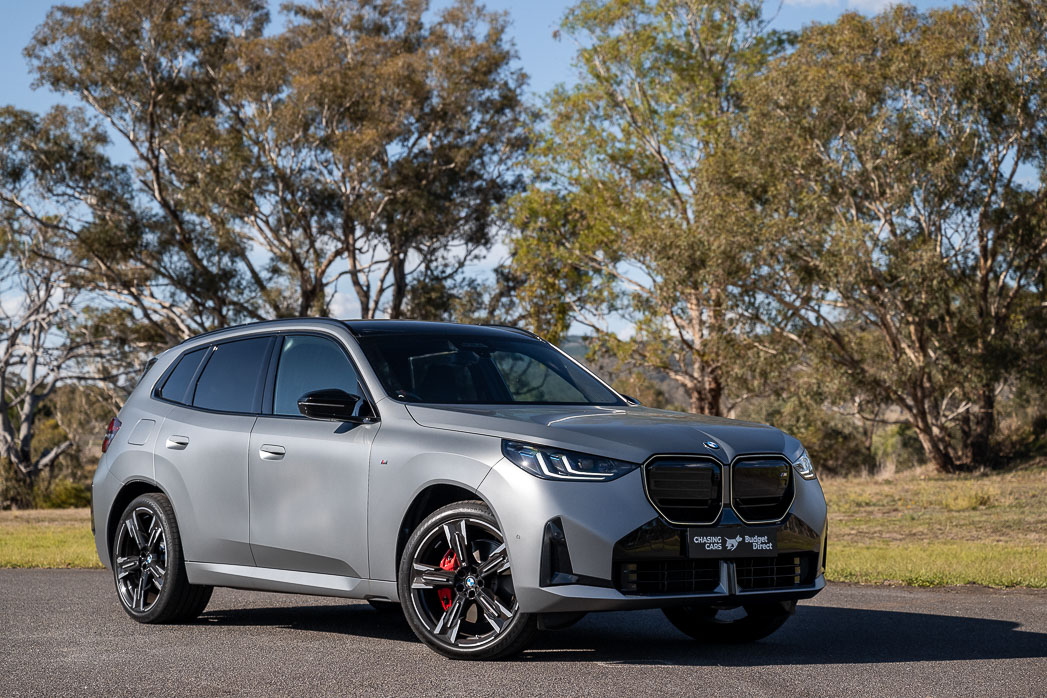
The combustion-engined X3 launches with three variants — none of which have an ‘i’ in the title, following the 1 and 2 Series’ lead — the entry 20, mid-spec 30e plug-in hybrid and the flagship M50 xDrive on test.
Replacing the M40i, the M50 uses a development of that car’s silky 2998cc twin-scroll turbocharged petrol inline six-cylinder with mild-hybrid boost helping drive power up 18kW to 298kW.
It’s what you see in the new X3 that really counts; the squatter proportions and futuristic imposing front end help it stand out in traffic. It’s adventurous, yet might not be everyone’s cup of tea. Some fresh standard colours, including Dune Grey of the tested M50, give the shape and even more contemporary twist.
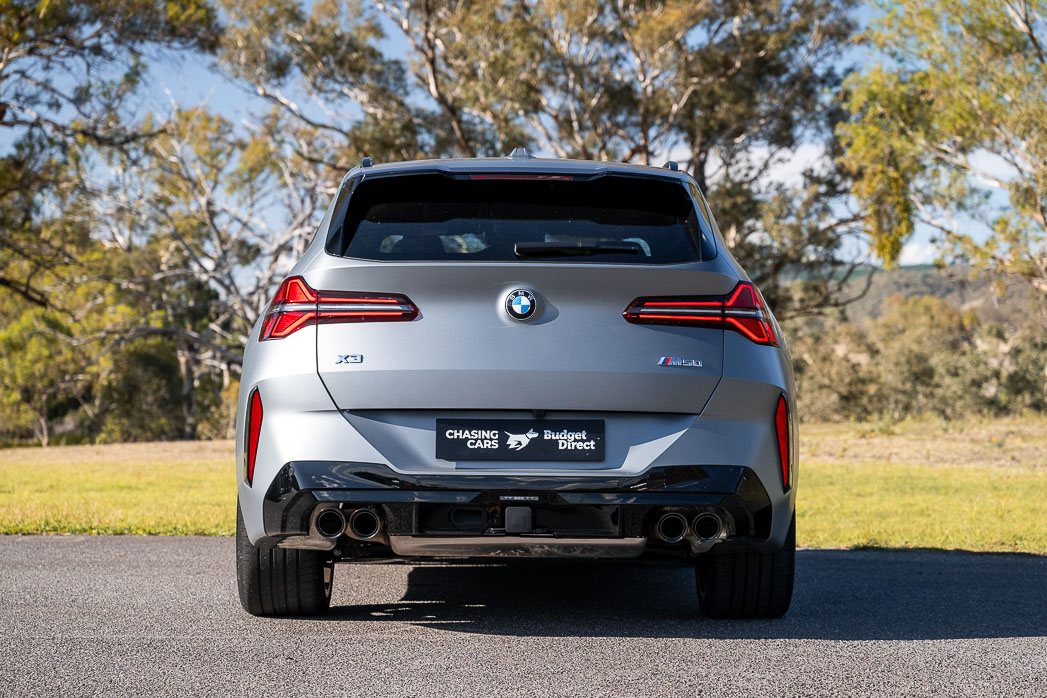
Look closer and you start to notice some familiar hardpoints, like the rise of the new X3’s A-pillar which is familiar, as is bonnet’s profile. It makes you wonder if BMW’s treatment runs more than skin deep.
What are the X3 M50’s features and options for the price?
The new BMW X3 starts at $84,500, before on-road costs and the tested M50 commands a whole lot more cash at $126,900. But there is value there, we promise. For a start, the new M50 is a mere $100 more than the old M40i.
Plus, by the time you’ve ticked all the options on the 20 you’re at $97,500 — a significantly smaller gap considering the M50 delivers over twice the power.
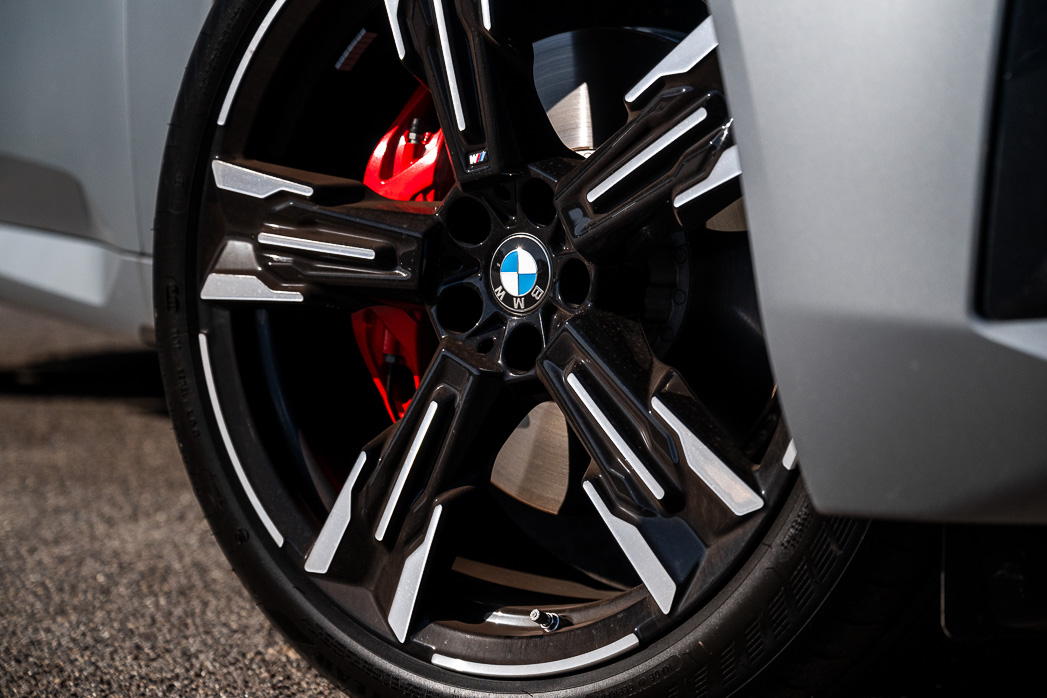
As for rivals, the most up-to-date on sale is the Mercedes-AMG GLC 43 at $136,900, though Audi’s new-generation SQ5 packing 298kW isn’t too far away and is likely to sit in the same ballpark, or a little below, the X3 M50.
The BMW X3 M50 features the following equipment as standard:
- 21-inch M alloy wheels (non-runflat tyres)
- Adaptive LED headlights
- Quad exhaust tips
- M-specific ‘Iconic Glow’ illuminated kidney grilles, mirror caps and aerodynamic elements
- Tri-zone automatic climate control]
- Acoustic glazing
- Power tailgate
- 14.9-inch touchscreen
- Operating system 9 with wireless Apple CarPlay and Android Auto
- Wireless smartphone charging
- 12.3-inch digital driver’s display
- 15-speaker, 750-watt harmon/kardon surround system
- Head-up display
- Keyless access with smartphone key
- Power adjustable front seats with heating and ventilation
- Heated rear outer seats
- Veganza synthetic leather upholstery
- M Sport Package inc. Steering wheel and Anthracite headliner
- Glass roof
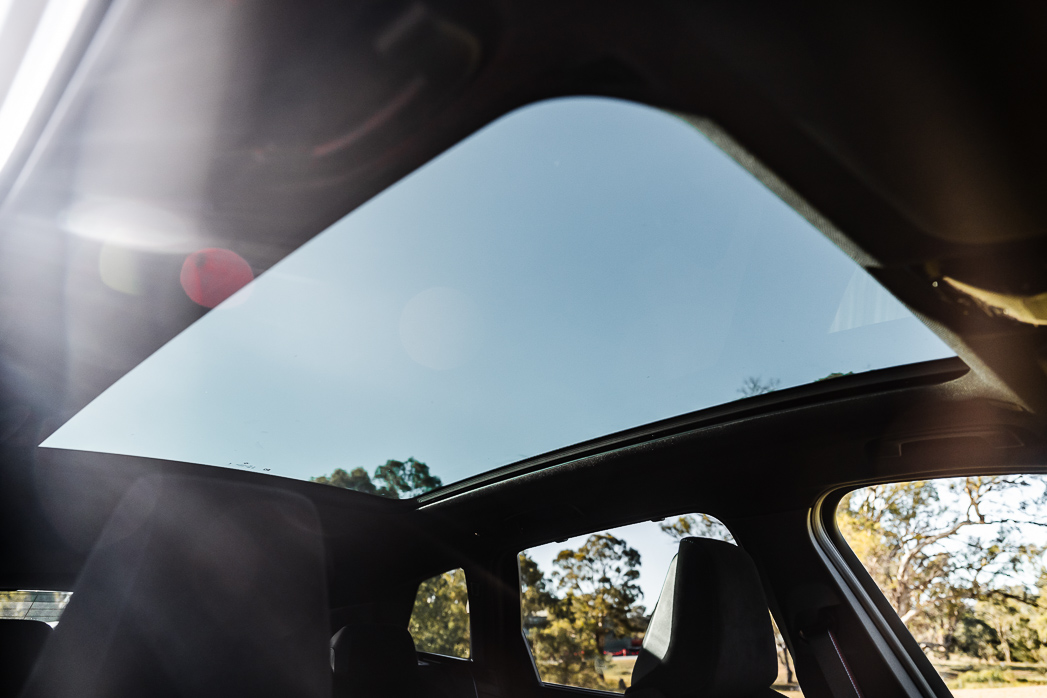
Despite fitting non-runflat tyres, the X3 is equipped with a tyre inflator kit and not a temporary spare.
How does the X3 M50 drive?
The outgoing BMW X3 M40i was a peach to drive. Lovely straight-six, slick transmission and well-judged level of athleticism. The latest G45 incrementally builds on those areas of excellence, delivering the most well-rounded X3 to date and, until we drive the new SQ5, the new class benchmark.
Broadening the X3 M50’s bandwidth required a full rethink of the chassis settings. Where old X3s relied on stiff springs for dynamic edge, the new G45 is more nuanced.
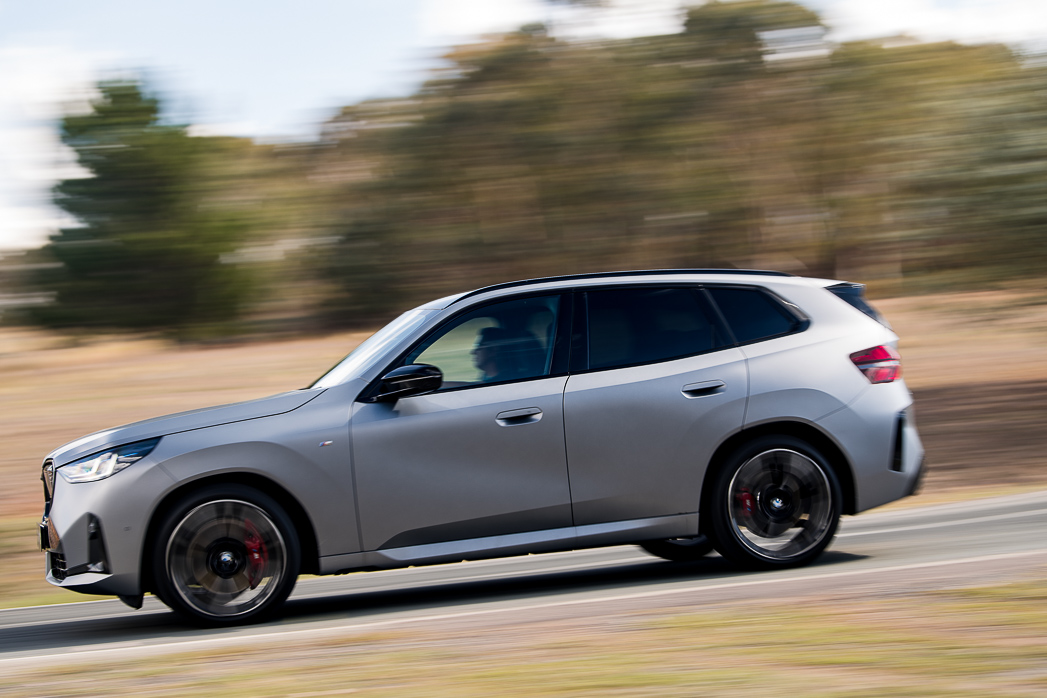
Despite huge 21-inch alloy wheels, the standard adaptive dampers move gracefully through their travel on Sydney’s rough streets in their softest setting. Noise is kept to a minimum thanks to standard acoustic glass and extensive insulation and BMW’s choice to ditch run-flats on the M50.
Ducking and weaving through tight streets the ZF eight-speed automatic expertly swaps cogs to ride the B58 3.0-litre inline turbo-six petrol’s torque wave (540Nm between 1900-4800 rpm).
The new 48-volt mild-hybrid system provides a 40Nm boost to a peak of 580Nm along with more seamless stop-start functionality, though the soft brake pedal at low speeds can make smooth stops tricky.
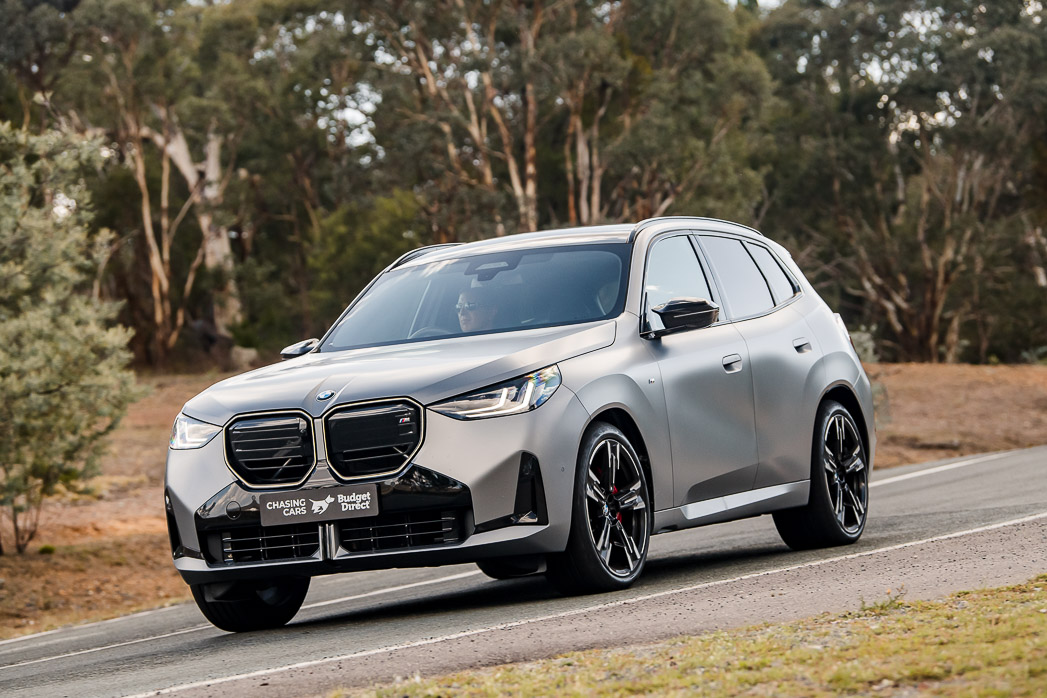
The other benefit of the inline-six (sadly the cold start is now much less dramatic) is a relaxing, omnipresent exhaust hum that builds into a full-bodied growl through the rev range. We’ll come to miss this.
Punch is plentiful for the traffic light Grand Prix and sneaking into gaps in traffic. BMW reckons you’ll get from 0-100km/h in 4.6 seconds, two tenths faster than before and a whole lot quicker than in the X3 20.
The extra power (298kW of it) makes the X3 come alive on country roads, exposing more of the chassis’ talents. The rear-biased xDrive all-wheel-drive system is more than happy to oblige on-throttle rotation through corners with the ESC giving plenty of scope for fun. Sport tightens the dampers up nicely but is best reserved for smooth tarmac.
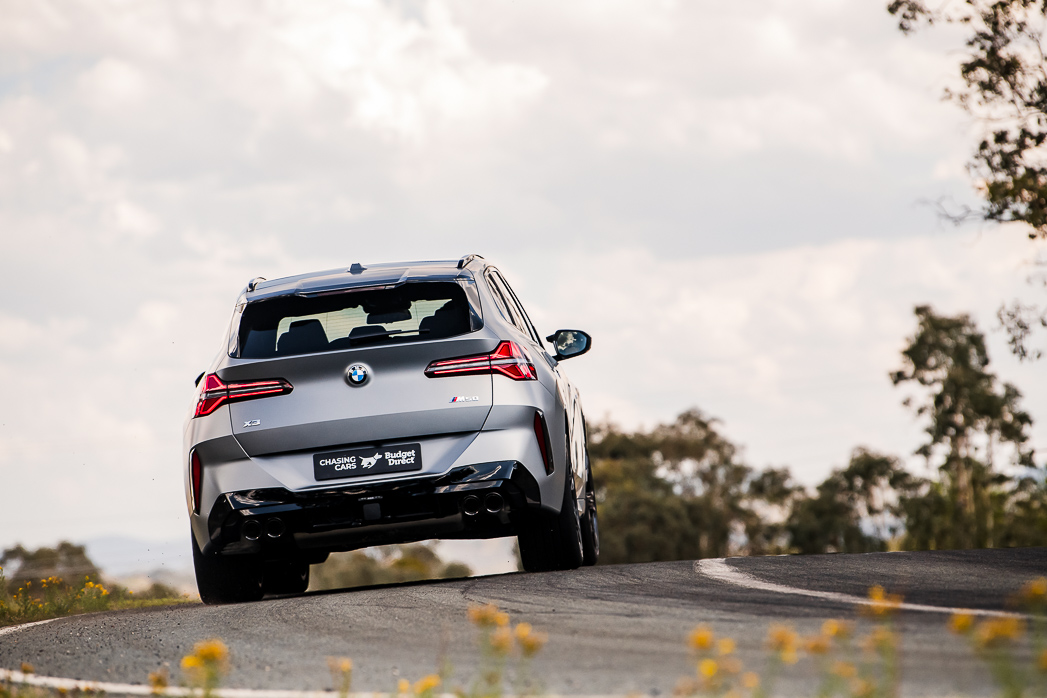
BMW’s missing a bit of a trick on drive mode selection in its non-M cars, though. They’re about three taps on the centre screen and obscurely named Personal, Sport, Expressive, and Art. The last two only adjust the cabin vibe and are wasted opportunities.
Strong uprated M brakes and direct steering — if lacking feel — inspire confidence on testing roads.
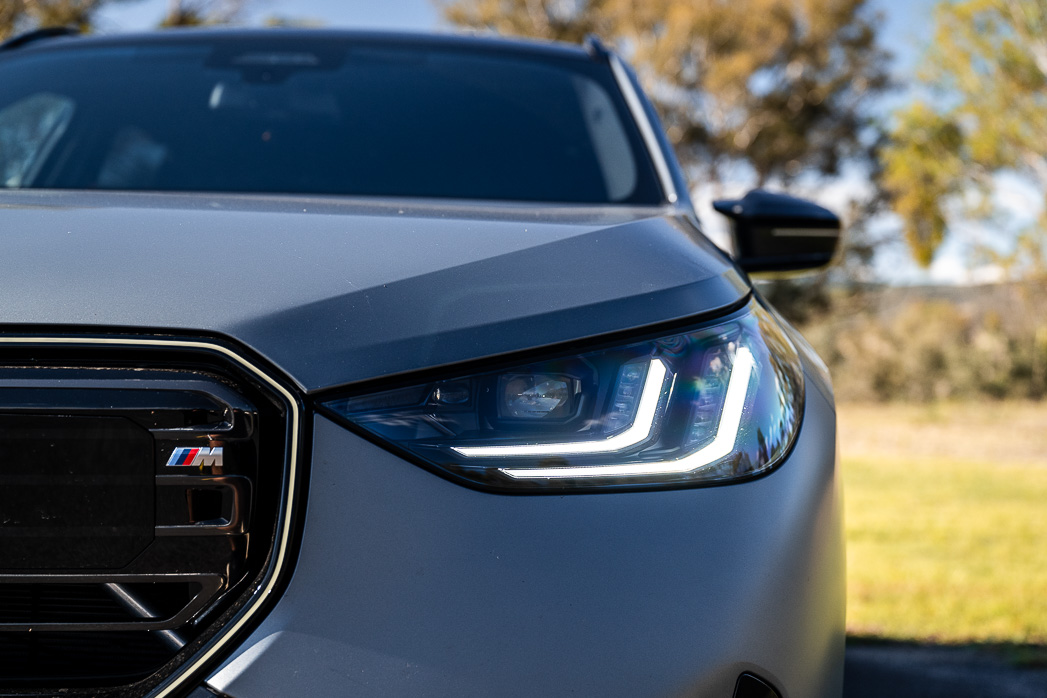
Special mention to the X3 M50’s adaptive LED headlights which danced around in the inky blackness to highlight wallabies and crucial road signs on a trip from Sydney to Bathurst (the interesting way) after dark.
What is the X3 M50’s interior and tech like?
The X3 appears to have jumped two generations from its predecessor inside, where the conservative, easy-to-use design has been replaced by a new iX-inspired interface dominated by screens and strips of translucent trim that glow with ambient lighting.
Where the old X3’s driving position was high-set, you sink down into the new car’s supportive and temperature controlled seats. Auto fan ventilation means you can enjoy the glass roof even on hot days.
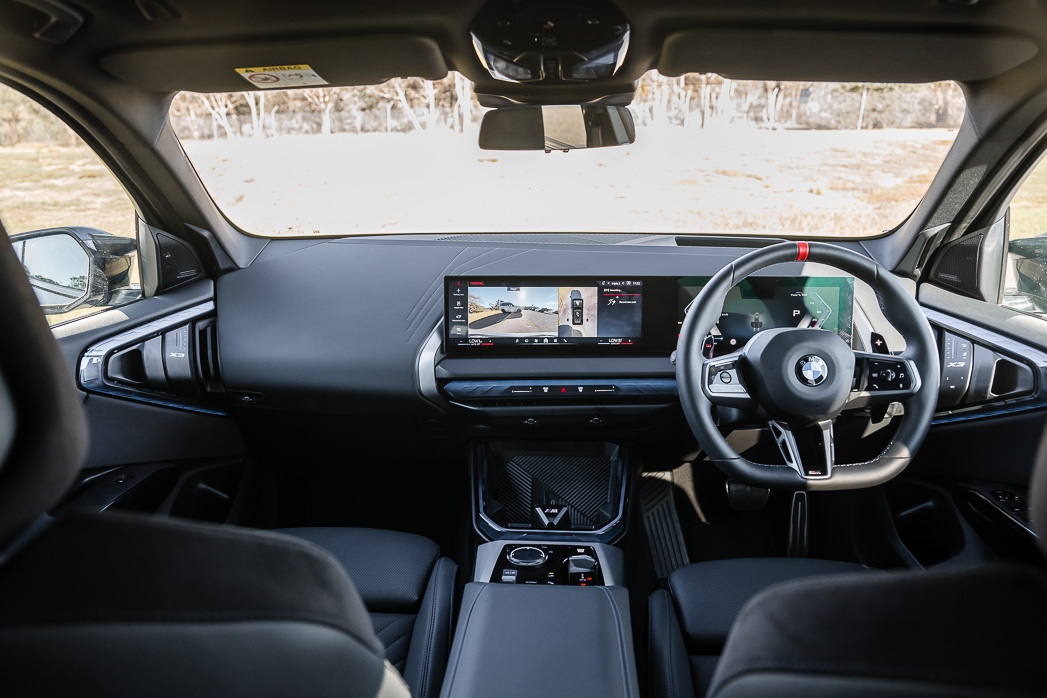
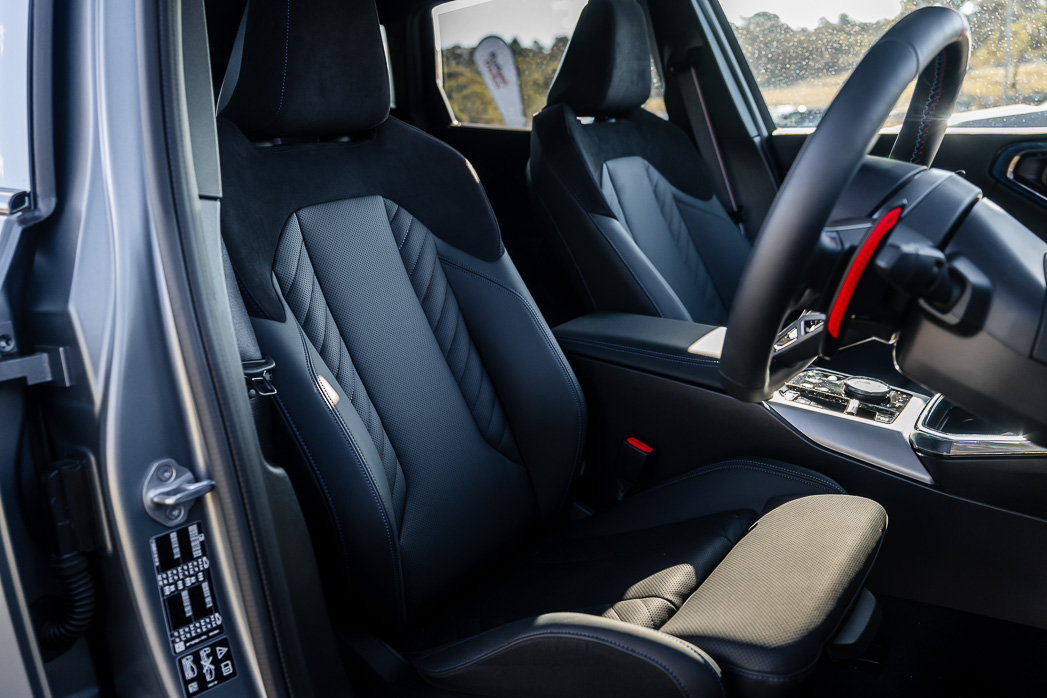
Although not from a cow, the X3’s Veganza synthetic leather upholstery is soft, never sweaty, and comes in three colours. Nappa leather’s available for an extra $4000.
Technology dominates in the form of a twin screen set-up for the driver that is bright and responsive. BMW’s persevered with touch climate controls, but at least there’s a persistent temperature bar for both passengers at the bottom. Plus, the array of excellent auto programs means you can easily set temp and fan strength parameters to your liking.
The control layout is mostly sensible with a few controls on the steering wheel and crucial ones, including the start/stop button, gathered around the toggle gear selector.
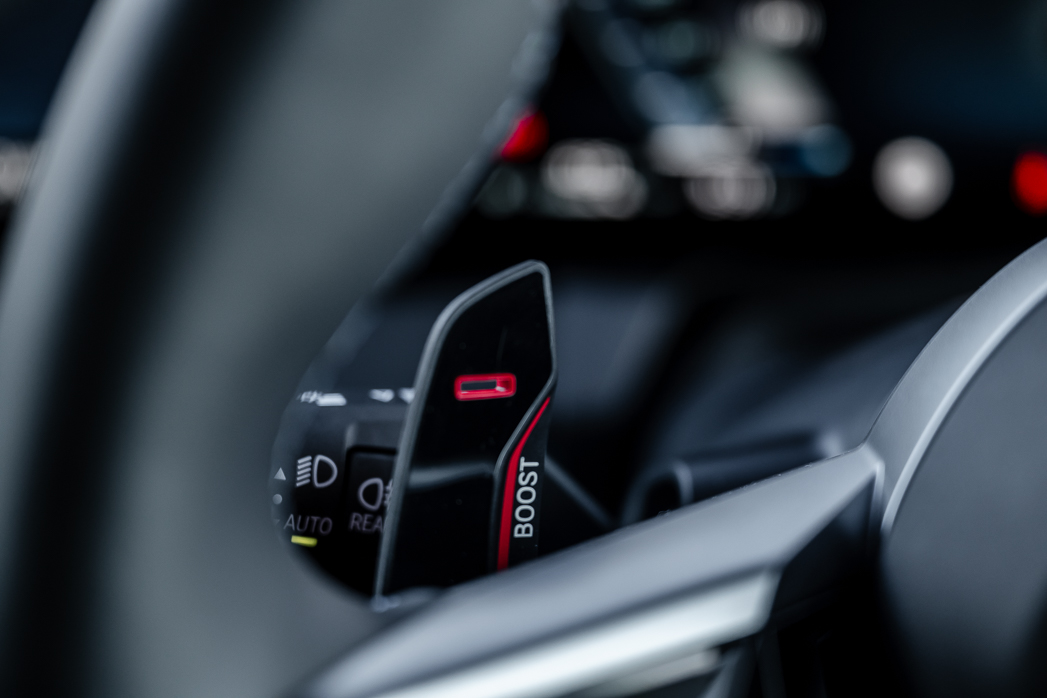
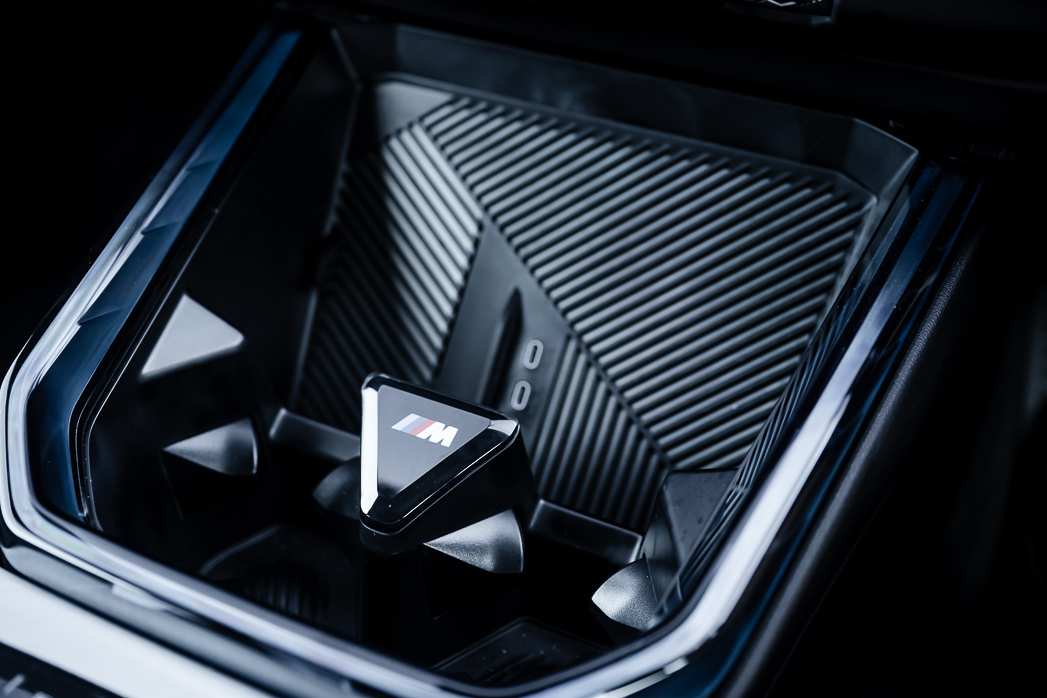
A wireless charging pad, two USB-C charge points, pair of small cup holders, reasonable door bins and a covered centre cubby give the X3 passable cabin storage.
The front passenger is very removed from the action with not much more than a slab of black plastic to look at, unless you (smartly) opt for the $1200 tactile knit weave dash cover.
Build quality is generally improved aside from the door pulls and plastic pull handles — both major touch points — which feel cheap and scratchy. Plastics below the beltline should be better.
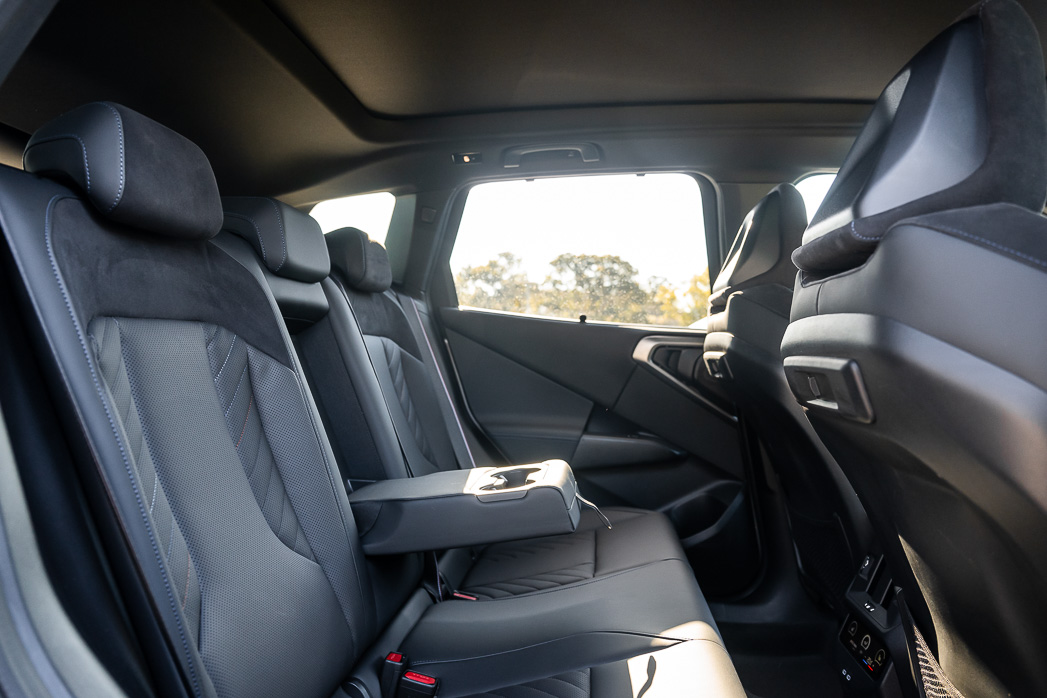
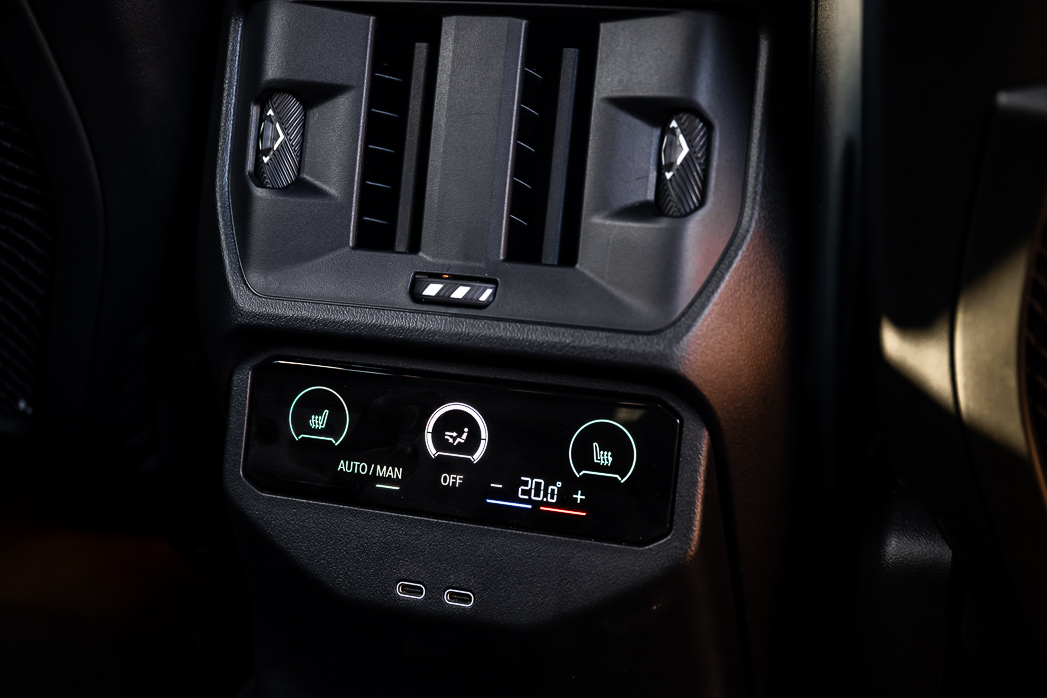
The X3’s back seat is spacious for full-sized adults with a good view out the side windows, however the lower roofline impedes forward visibility.
Rear roller blinds and fold-out armrests with two cup holders are standard. The attractive tombstone front seats have a phone cradle easily in reach of a USB-C port, but they cost a painful $439 apiece.
A standard power tailgate opens up the X3’s generous 570-litre boot which expands to 1700L when the 40/20/40 backrest is folded.
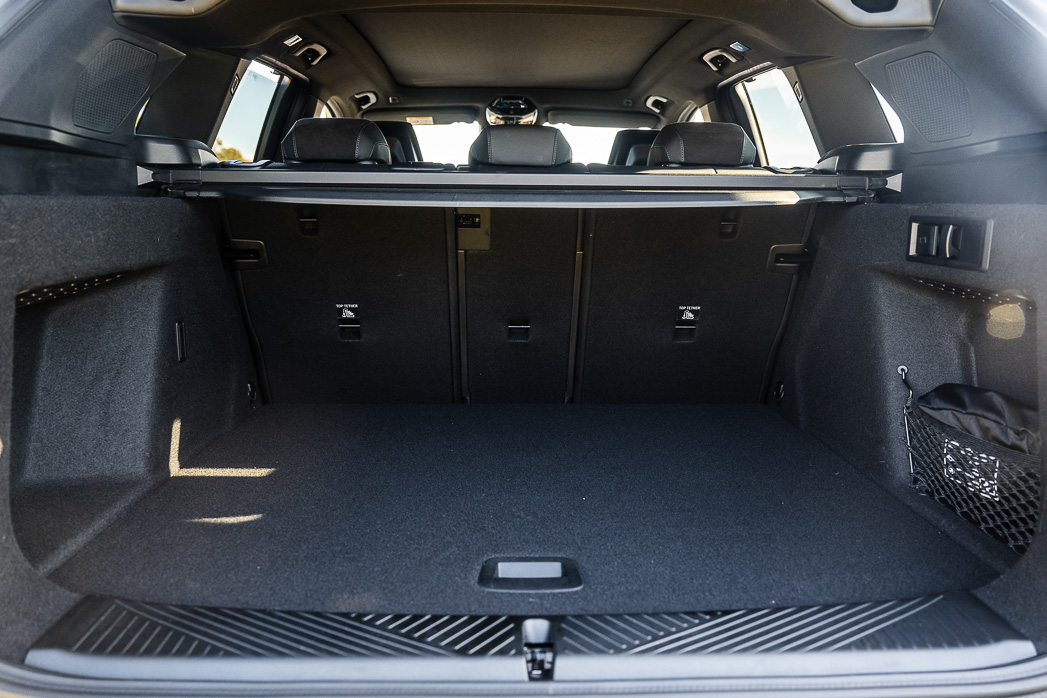
There’s snazzy patterned trim on the boot lip, some extra underfloor storage, three easily accessible top tether points and a pair of netted cubbies off to the sides.
Is the X3 M50 a safe car?
The G45 BMW X3 is yet to receive an ANCAP or Euro NCAP safety rating.
The X3 is fitted with auto emergency braking (AEB) with pedestrian, cyclist and junction detection, lane-keep assist, blind-spot monitoring, rear cross-traffic alert, 360-degree camera system, and tyre pressure monitoring.
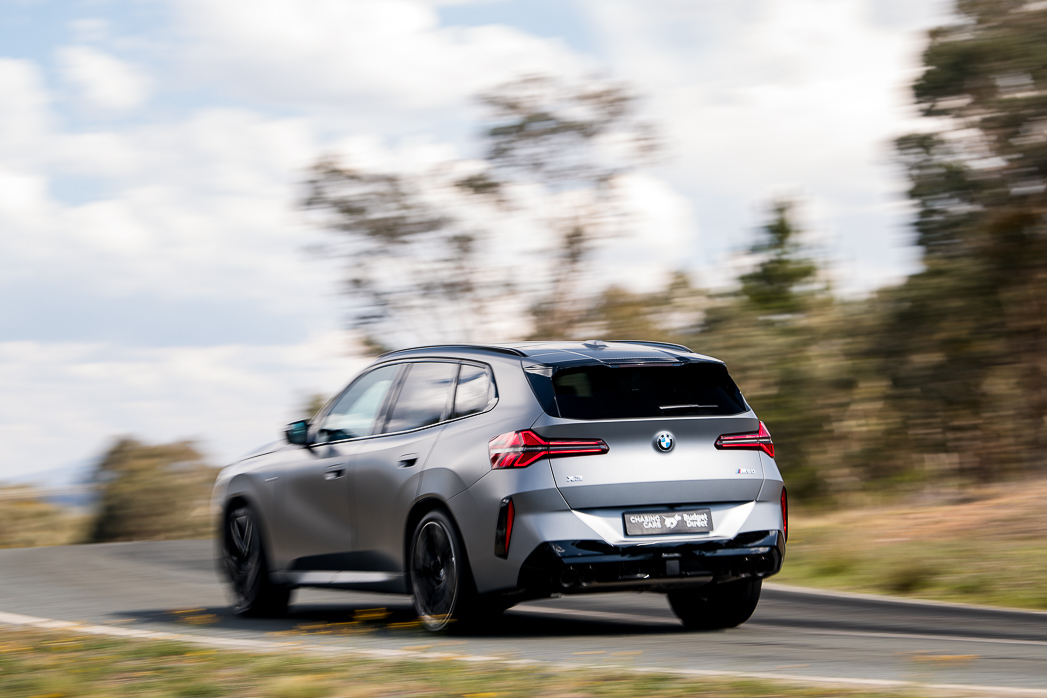
BMW’s Driving Assistant Professional suite is standard, featuring adaptive cruise control with stop and go along with auto lane-change — just turn on the indicator and all the sensors will read the road and decide whether it’s safe, before steering the X3 into the other lane.
In practice, BMW’s systems work brilliantly and are some of the best on the market. Functions like driver drowsiness detection and speed sign recognition were genuinely helpful on test.
What are the X3 M50’s ownership costs?
With more power, torque and displacement you might expect the X3 M50 to be a lot less efficient than the 20. The truth is, mild electrification and right-sizing pays off for this 1980kg SUV.
Compared to the combined ADR rating of 8.2L/100km, the X3 M50 returned a figure of 7.8L/100km according to the trip computer after more than 500km of driving including an out-and-back run from Sydney to Bathurst and urban driving in Sydney traffic. BMW even says the X3 M50 will accept 91 RON regular unleaded petrol.
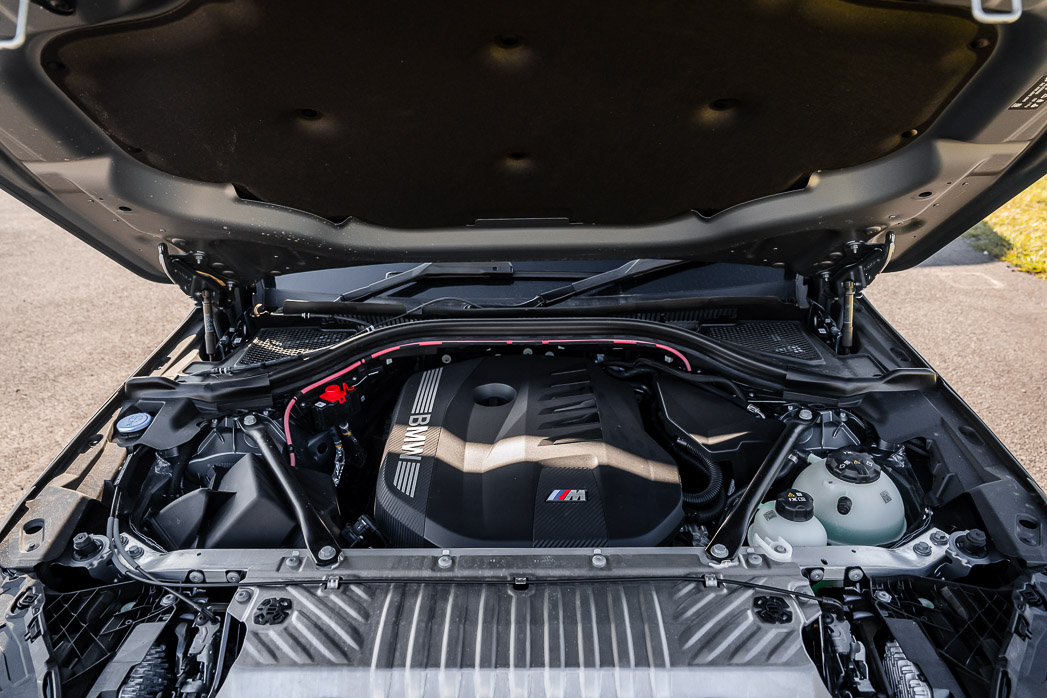
The X3 will prompt owners for service based on condition, but BMW’s guide is roughly every 12 months or 20,000km. The Service Inclusive Basic pack that covers scheduled servicing for five years or 80,000km costs $2475 for the X3. For reference, that’s a third of what a Mercedes-AMG GLC 43 will cost to service over the same period.
The BMW X3 is covered by a five-year/unlimited kilometre new-vehicle warranty in Australia. Roadside assistance is also included for three years.
The honest verdict on the X3 M50
A heavy redesign of both the cabin and sheetmetal give the appearance of an entirely new vehicle but BMW didn’t go back to the drawing board for the new G45 X3.
Of course there are some shortcomings: scratchy plastics scattered around the cabin, touch-heavy interaction and those extra two drive modes that feel pointless. With strong safety equipment and an ownership experience that matches key rivals, there’s little else to complain about with the X3.
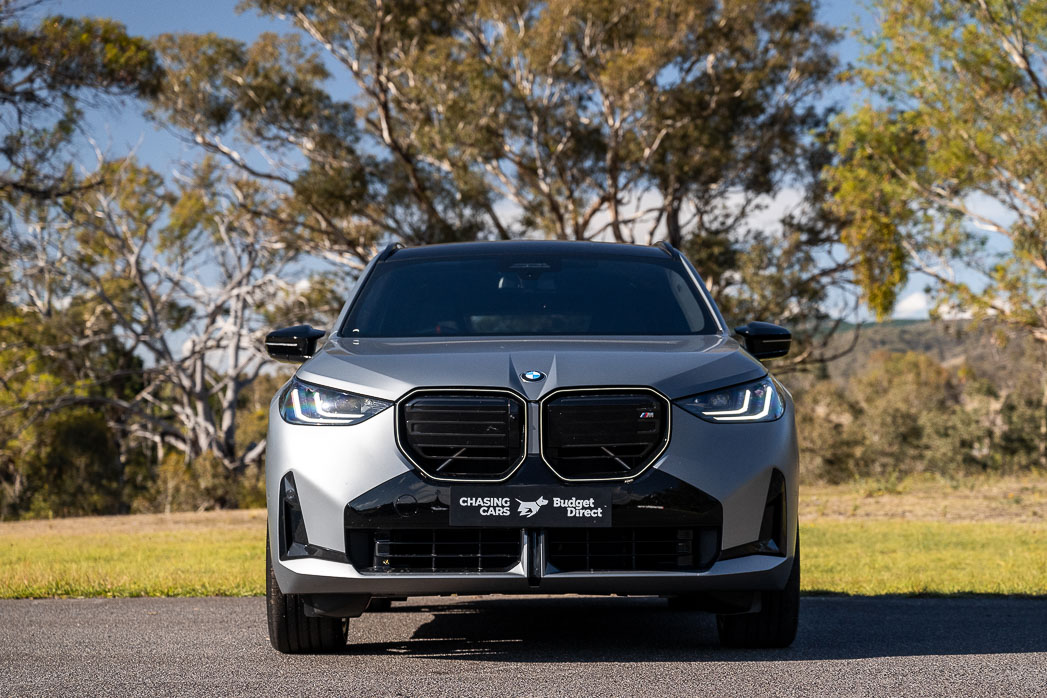
The upgrades under the skin are mostly incremental and that’s exactly what was needed — the fundamentals were already class-leading and, if you can justify the price, the M50 unlocks BMW’s signature pace, sound and dynamic polish.
Overall rating
BMW X3 20 xDrive 2025 review
7 months ago

BMW’s fourth-generation X3 comprehensively refines and improves the previous gen’s hardware, with the intention of being the world’s best-driving medium SUV
Good points
- Handsome exterior styling
- Deeply impressive dynamics
- Excellent refinement
- Overall driveability and efficiency
- Improved value for money
Needs work
- Some inexpensive cabin plastics
- Base engine deserves more power
- Noisy front-seat ventilation
- No cloth-seat option for Australia
- M Sport styling is mandatory
The BMW X3 may have started its life as a niche offshoot of the towering 3 Series nameplate, but such is its growth in prominence over the past two decades that it’s now BMW’s best-selling model globally and has been freshly rejuvenated to thrust it towards the 2030s.
The fourth-generation G45 X3 you see here isn’t a completely new model – it shares its CLAR platform, 2865mm wheelbase length and core drivetrains with the previous G01 model – but it’s visually all-new, with hardware substantially upgraded to deliver the best-driving medium SUV in the business, regardless of price.
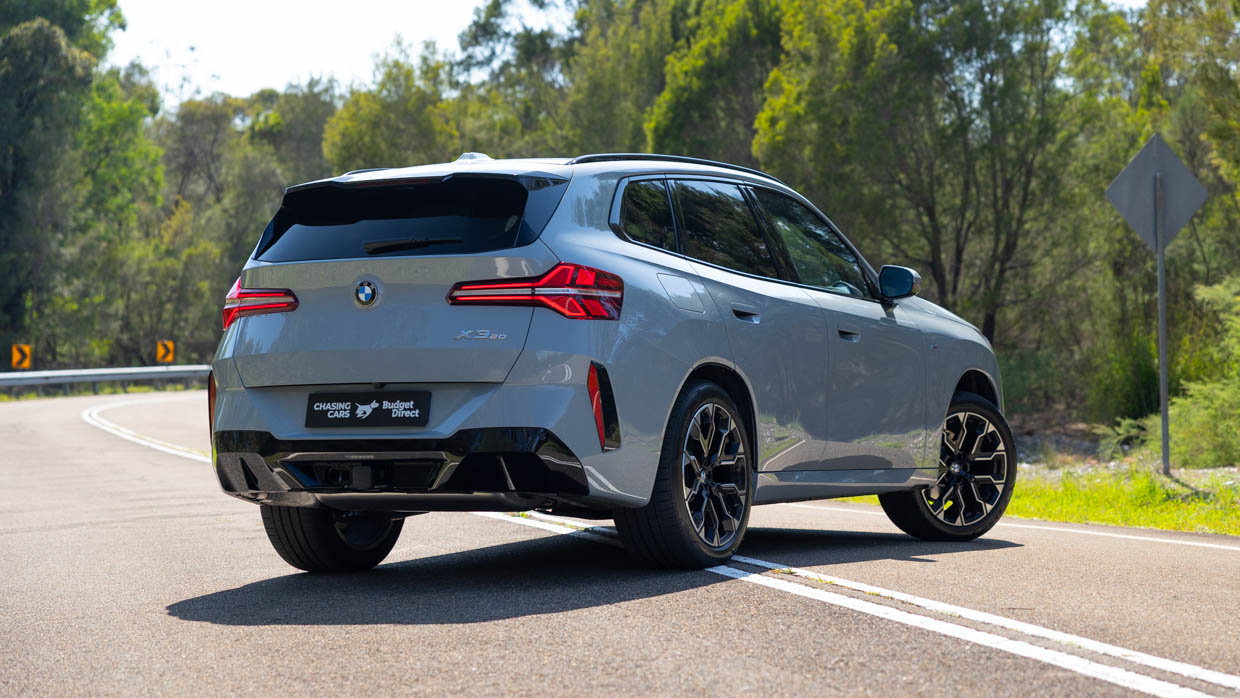
To build on the X3’s already-impressive packaging, BMW has widened it by 29mm, lengthened it by 34mm and lowered it by 25mm. And to enhance its already-strong dynamic ability, BMW has broadened its tracks (16mm front, 45mm rear), honed its suspension geometry, revised its steering hardware, and fitted adaptive dampers as standard on M Sport models.
The Australian line-up consists of three X3 variants, all featuring ‘xDrive’ all-wheel-drive and standard M Sport package. The entry-level X3 is the 20 (tested here) – with 140kW/310Nm and an $86,100 sticker before on-road costs.
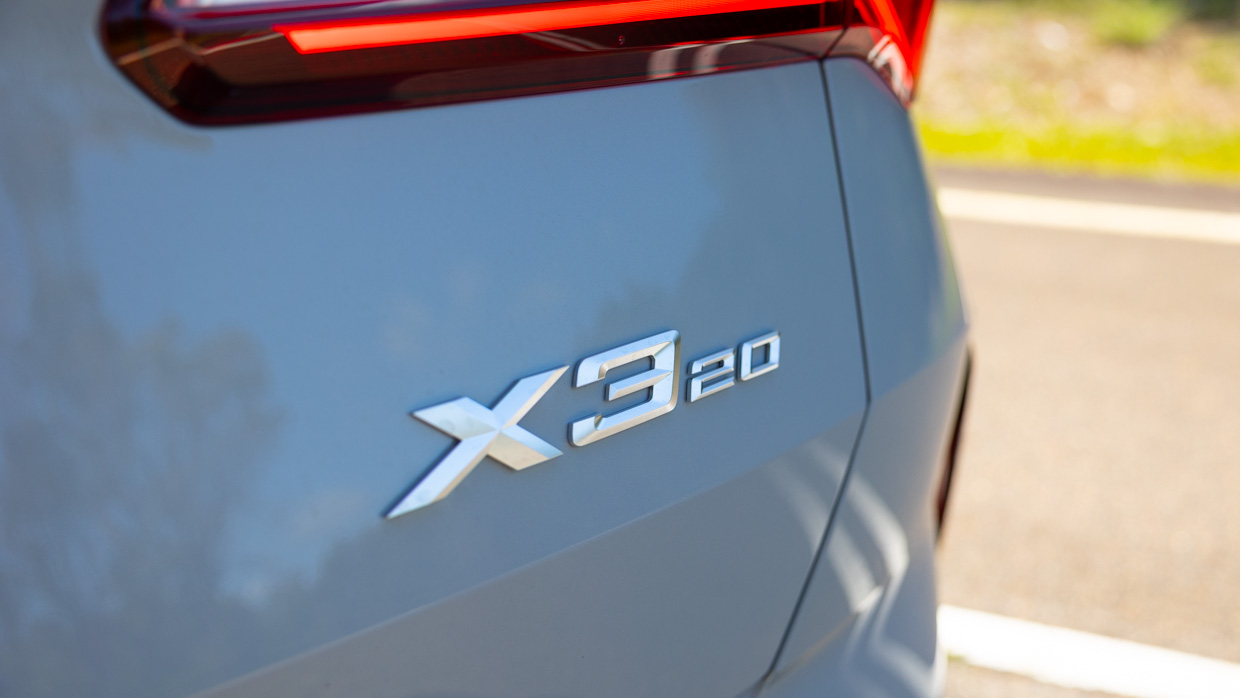
Above it sits the X3 30e – a plug-in hybrid evolution of the 20, with a 19.7kWh battery, total system outputs of 220kW/450Nm and a before on-roads price of $102,500. And the storming 293kW/580Nm X3 M50 six-cylinder turbo-petrol for $128,900 before on-road costs.
The existing all-electric iX3 will continue for now but will be replaced by a totally new EV model line later in 2025 – based on BMW’s Neue Klasse X concept shown in early 2024. Meaning that the emergence of the G45 X3 marks the divergence of BMW’s combustion-engined medium SUV line-up from future electric SUV models.
What are the X3 20’s features and options for the price?
BMW Australia has comprehensively increased the base X3 20’s level of standard equipment over the previous rear-drive 20i model, for around a $4000 increase in price.
New standard equipment includes:
- ‘xDrive’ all-wheel drive
- 48-volt mild-hybrid engine tech
- Acoustic glazing
- Adaptive suspension
- ‘Iconic glow’ illuminated kidney grille
- Curved 12.3-inch driver’s display and 14.9-inch touchscreen
- Operating System 9 software
- Driving Assistant Professional with steering- and lane-control system
- M Sport package
- Anthracite M headlining
- M Sport leather steering wheel
- Parking Assistant Plus (surround view, reversing assistant, drive recorder)
- Heated front seats
- ‘Verganza’ perforated faux-leather upholstery
- Tyre-pressure monitoring system
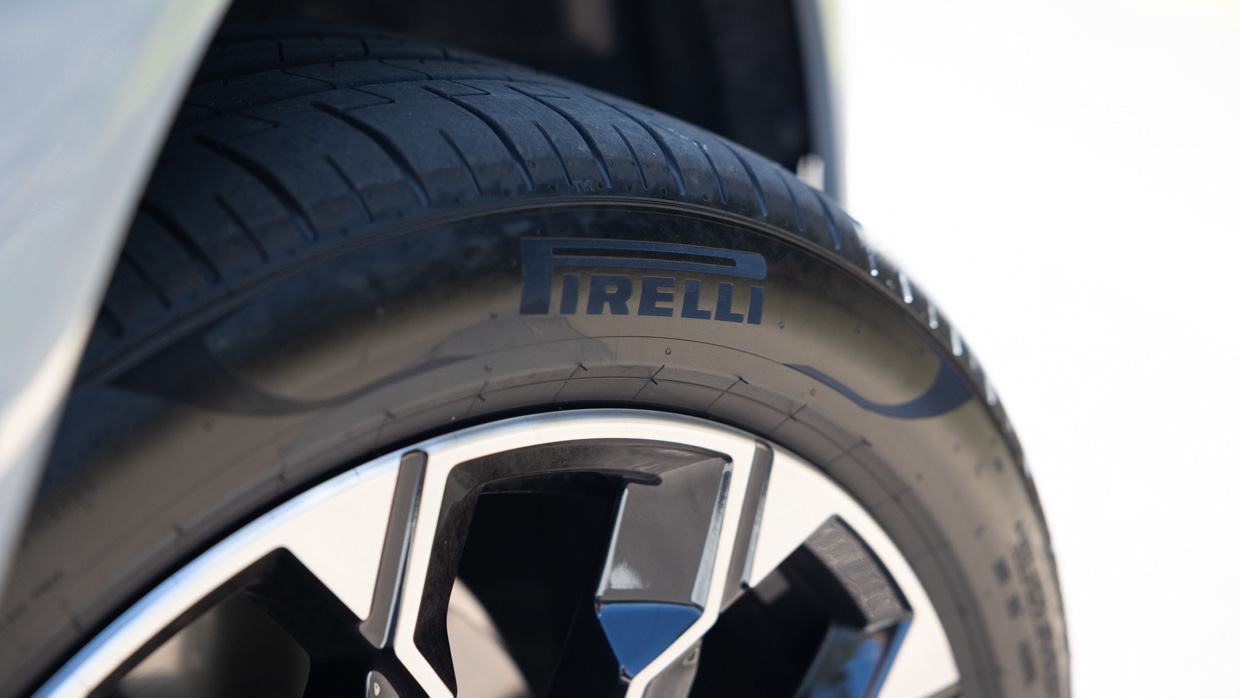
This is in addition to features such as:
- 19-inch M light-alloy wheels with run-flat tyres
- Adaptive LED headlights
- Electric tailgate
- Keyless entry/start
- Three-zone climate control
- Six-speaker 100-watt sound system
- DAB+ digital radio
- Electric front seats
- Adaptive cruise with stop-and-go
- Head-up display
- OTA upgrade capability
- Wireless Apple CarPlay/wired Android Auto
- Wireless phone charging
Our test car also included an Enhancement Pack ($6000 – metallic paint, alarm system, panoramic glass sunroof and 15-speaker, 750-watt Harman Kardon surround-sound audio), as well as a Comfort Pack ($4000 – front seat ventilation, heated steering wheel, rear-seat heating, rear door sunblinds, rear privacy glass, luggage net), and 20-inch M double-spoke alloys ($2000) with a tyre-inflation kit (replacing run-flats).
How does the X3 20 drive?
If there’s one area where the BMW X3 has consistently performed strongly, it’s driving dynamics. Not the flawed first-generation model, but definitely the next two, and now this fourth-generation G45.
BMW wanted to deliver the best handling and steering in the premium-medium SUV category with the new X3, and it has succeeded.
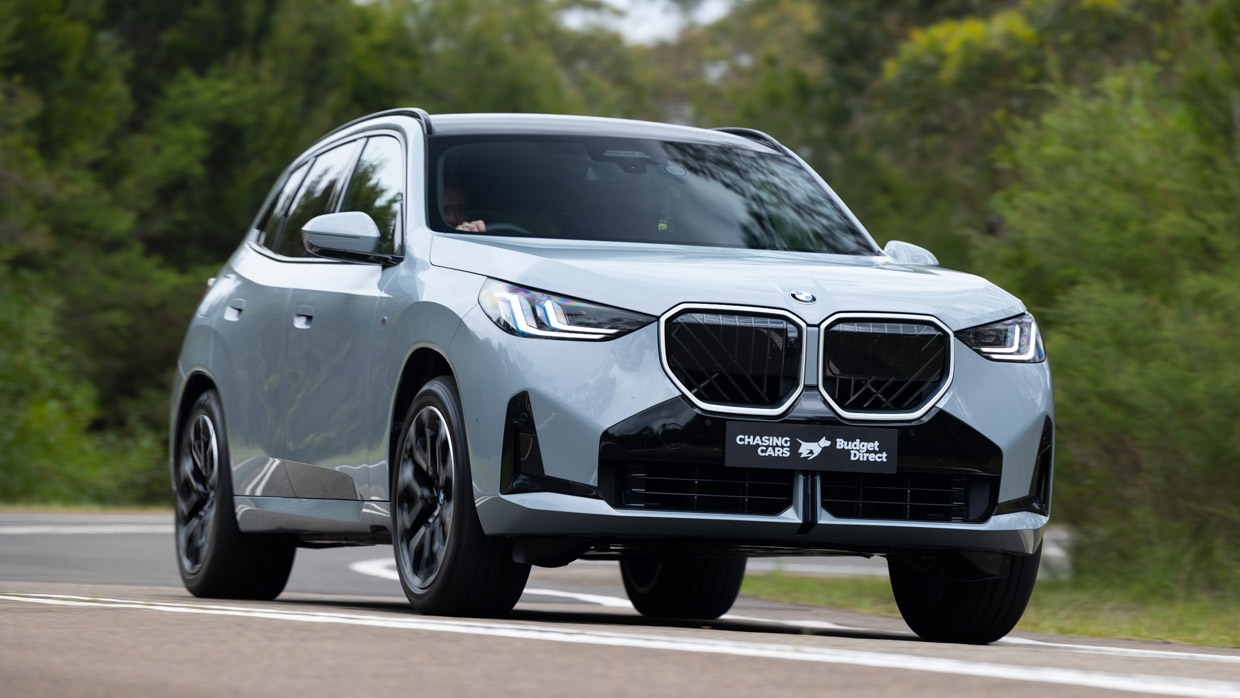
From the moment you turn the G45 X3’s steering wheel, there’s a tangible sense of poise and connection from its chassis, and the more lock you wind on, the greater the involvement with its handling balance and suspension composure.
Now that the X3’s standard M Sport package includes adaptive M suspension with adaptive damping, there’s a newfound fluency to the way it strings corners together, as well as a newfound absorbency to its ride quality.
Our test car featured optional 20-inch M alloys with mixed-width tyres (Pirelli P Zero 255/45R20 front and 285/40R20 rear) which aren’t run-flats (unlike the standard 19s) so perhaps they improve its ride.
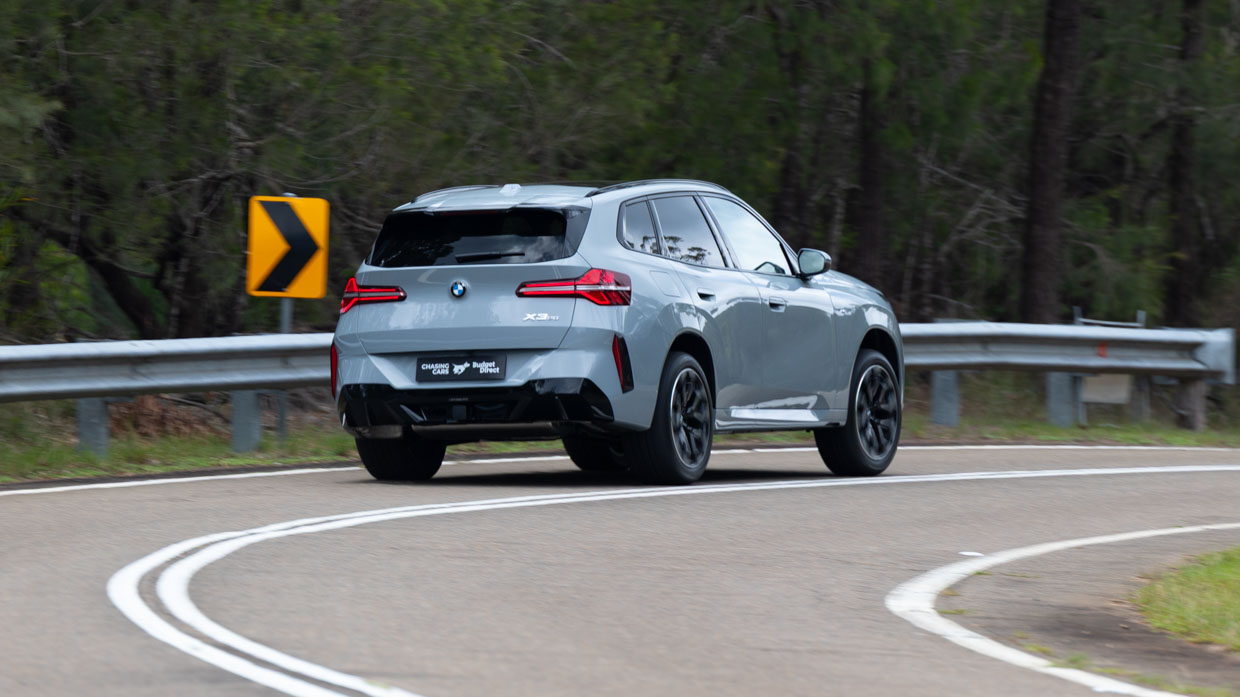
Whatever the result, this is the first regular X3 wearing M Sport kit and 20s that doesn’t crucify its passengers for the sake of looking tough.
With standard acoustic window glazing, the G45 X3 is quiet as well – isolating its passengers from external noise without isolating its driver from what’s going on underneath.
And that also applies to the 2.0-litre turbo-petrol four-cylinder engine, even when being repeatedly extended to the redline … which can be often on challenging roads. It whirrs away with a subdued spirit that lacks rasp and sporting zest, yet it sounds quite pleasant.
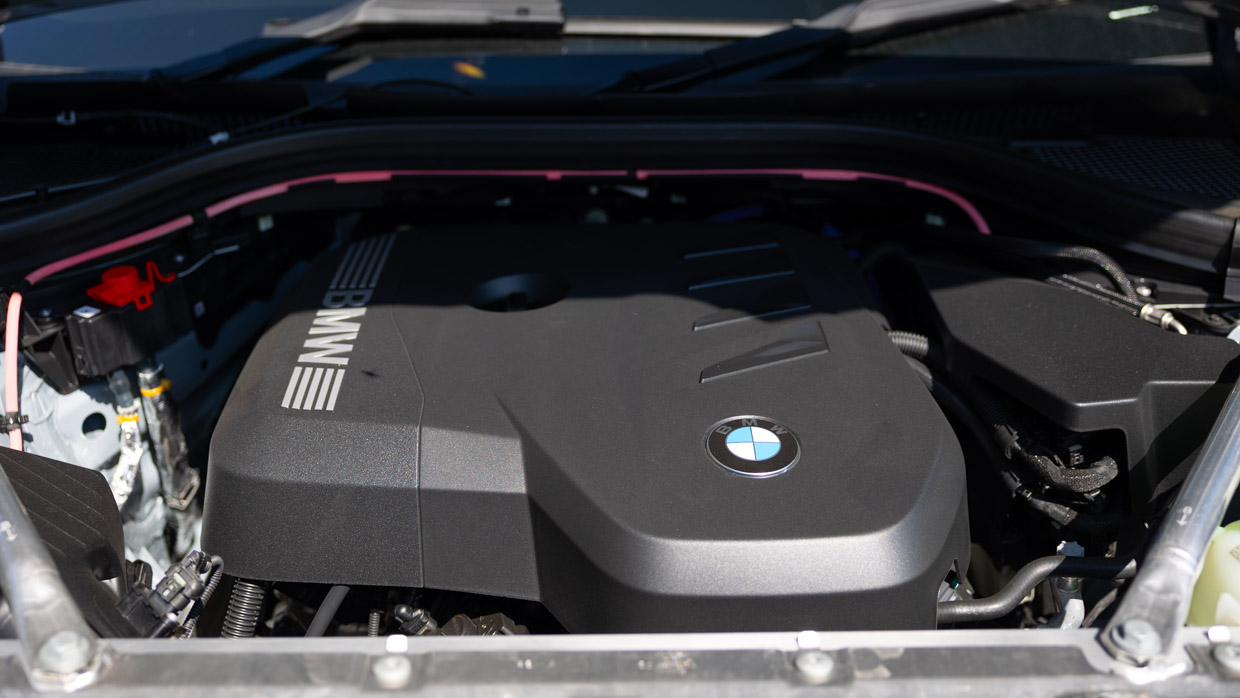
With only 140kW (from 4400-6500rpm) and a decent 310Nm (from 1500-4000rpm), there isn’t a whole lot of engine to lug around 1855kg, despite the new X3 being both stronger and lighter. Yet in regular driving situations and urban commuting, this drivetrain is excellent.
Expertly calibrated and working with a superb eight-speed automatic, the X3 20 is brilliant at making the most of everything that it has – to the point where it rarely feels underdone when hammering around hilly cities like Sydney.
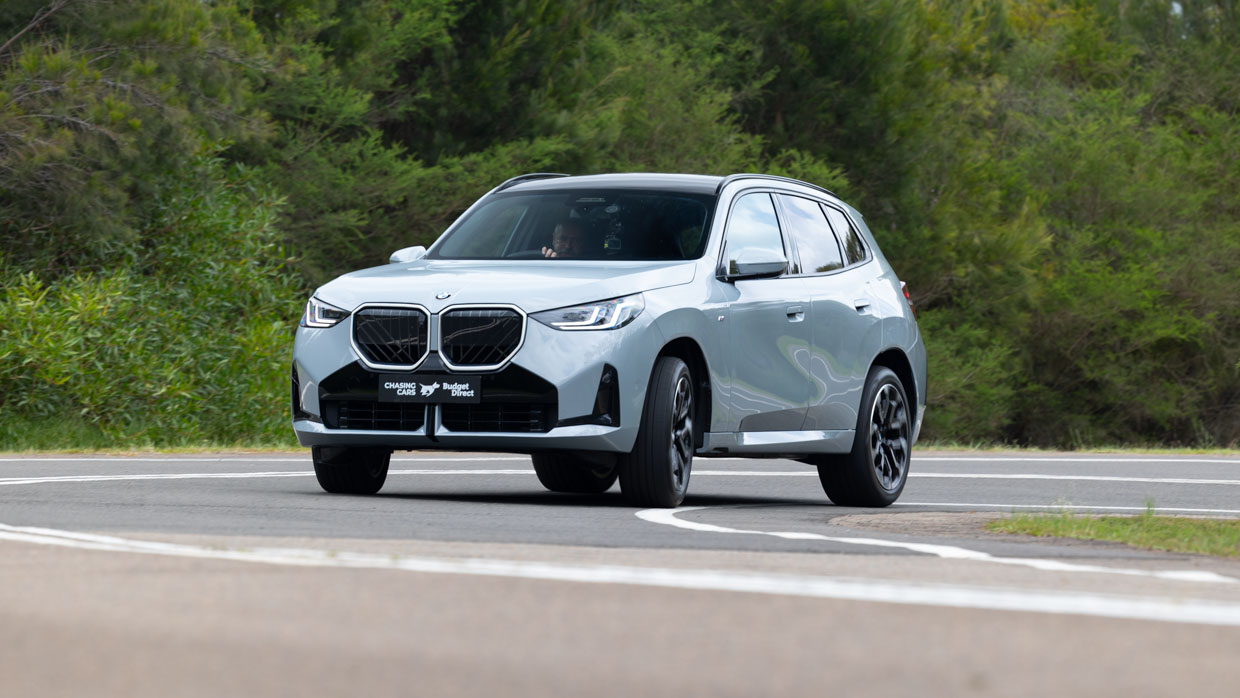
But we suspect the X3 would’ve been no less economical but much more effortless had it used the 190kW/400Nm engine tune from the 330i – putting it on par with the 190kW Mercedes-Benz GLC 300 and 185kW Audi Q5 2.0 TFSI.
Perhaps BMW has restricted engine availability to give the 225kW plug-in hybrid 30e some breathing space. Either way, if you aren’t too interested in genuine performance, you’ll look long and hard to find a drivetrain as finessed as the X3 20s.
What is the X3 20’s interior and tech like?
Right-sizing the exterior of the new X3 has also played out well in its interior. With a less-obtrusive dashboard design, front passengers feel blessed with space but they also feel like they’re in a smaller car than a 1920mm-wide medium SUV.
This works for both the intimacy of the driving experience, as well as a feeling of airiness.
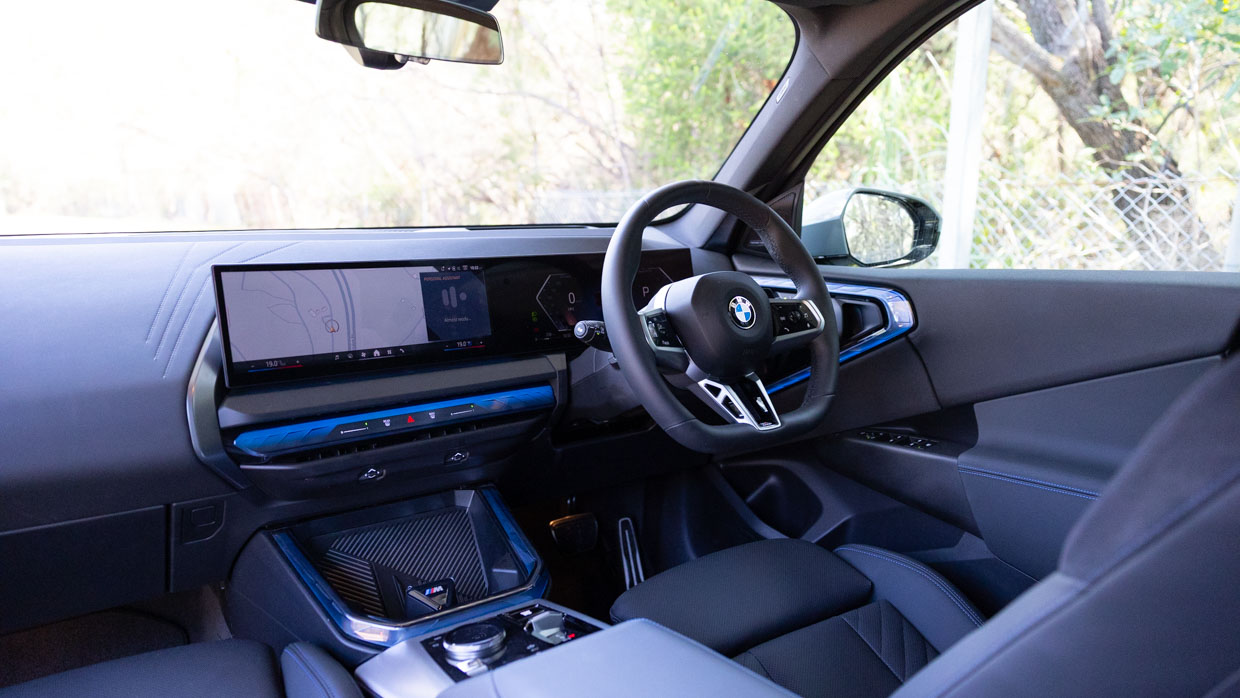
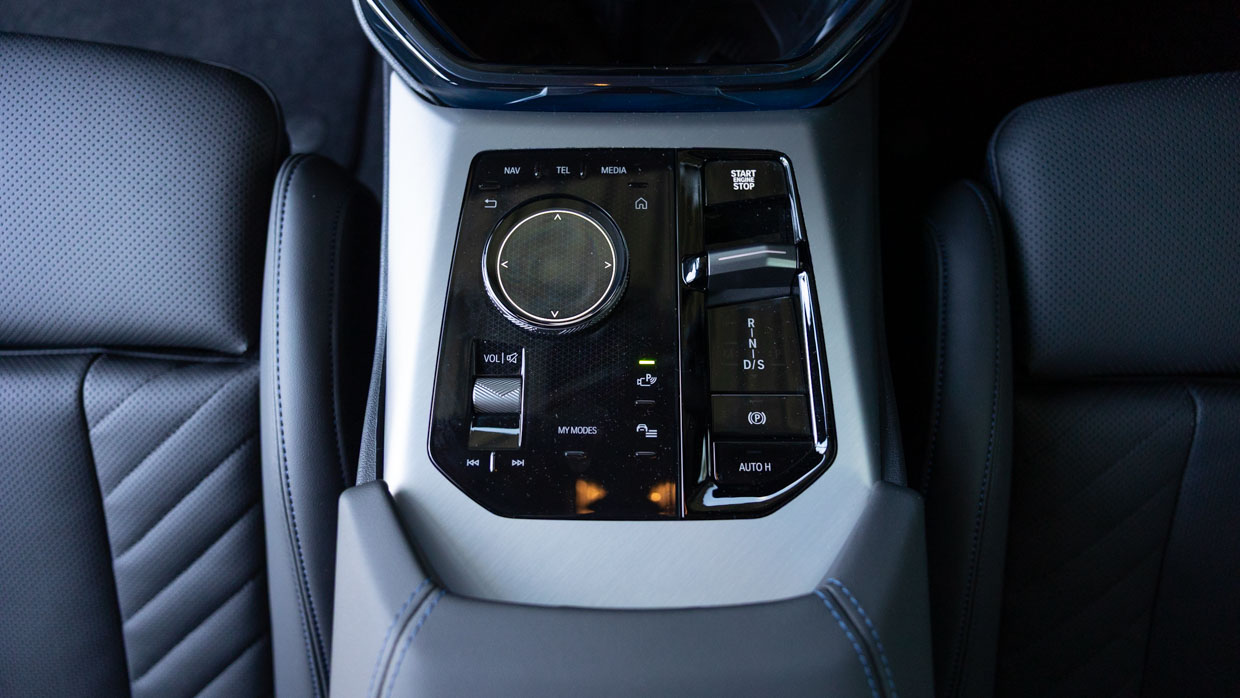
In terms of design, the new asymmetrically shaped dash blends beautifully with the doors and offers an optional knitted cloth covering (for $1200) that also extends into the door tops (front and rear) to make the X3 feel plusher.
But it almost needs that cloth overlay to make it feel luxurious because the plastics and finishes don’t look or feel as expensive as in the previous model.
The standard M Sport interior gets a vinyl-clad dash with knitted M tri-colour stripes, which is nice. But it’s the plastics around the centre air vents, door air vents and the door pulls that look and feel hard and non-premium.
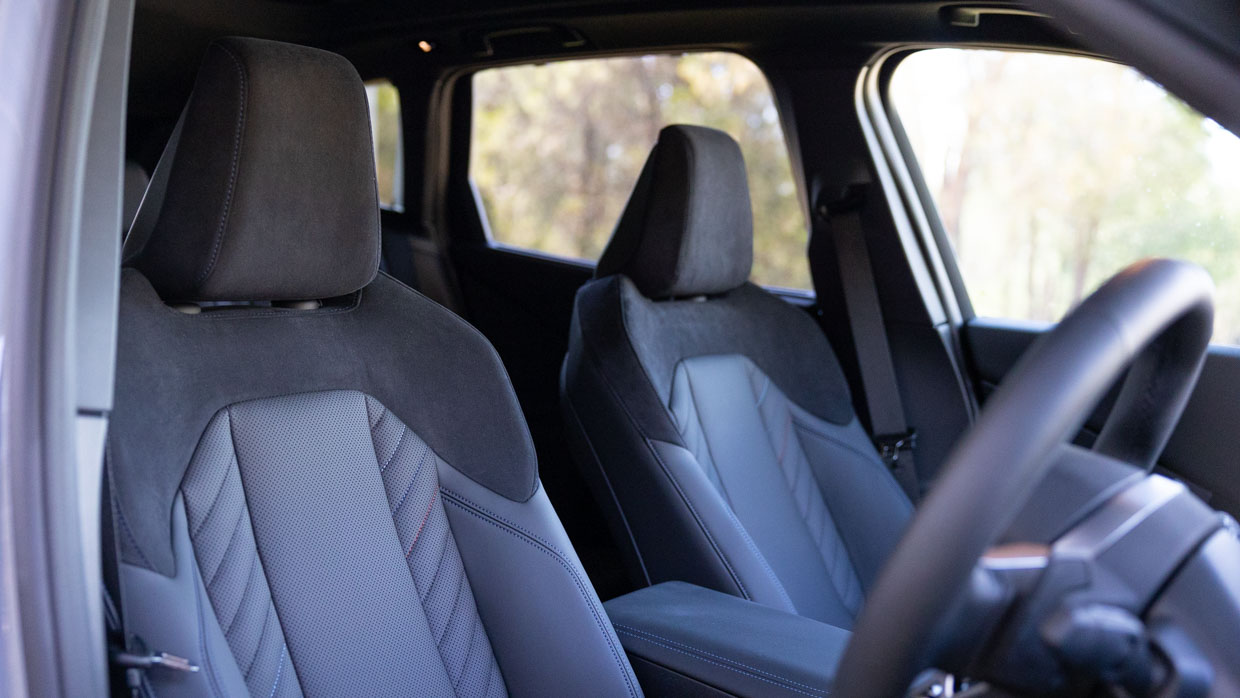
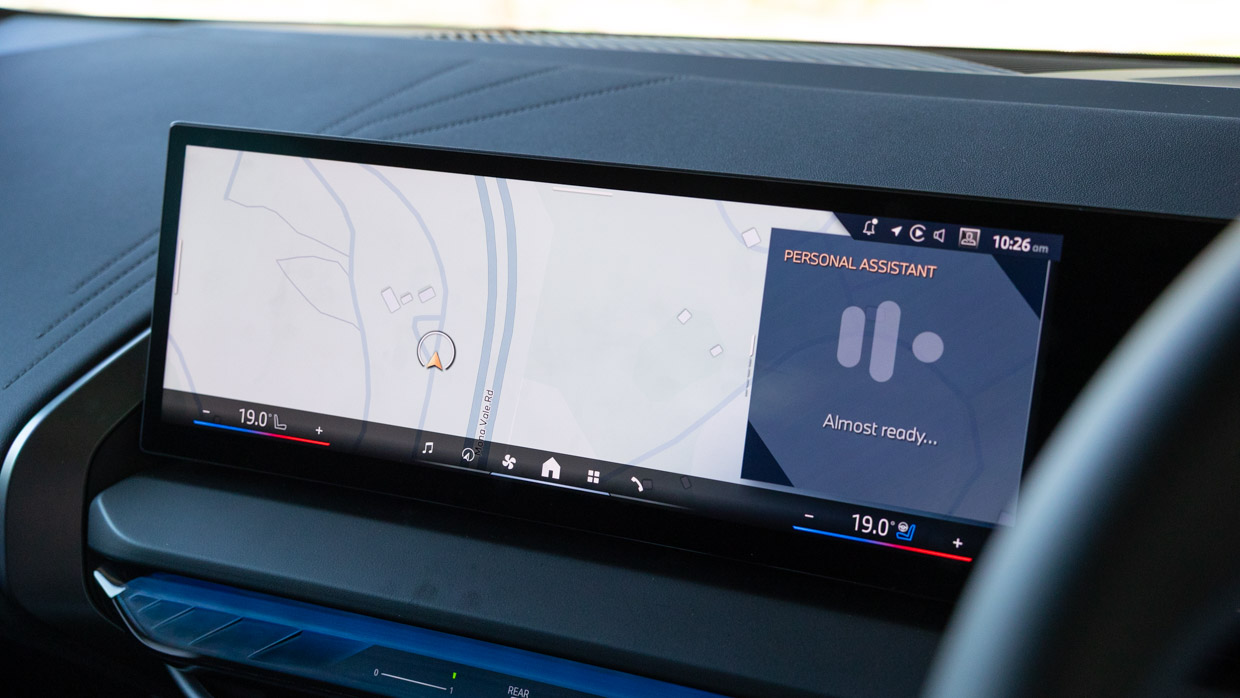
And the door panels with ‘X3’ written on them, next to the new adjustable air-flow touch sliders, were unexpectedly flimsy in our test car and could be flexed significantly.
All that aside, the rest of the interior quality is fairly impressive, including well-stitched perforated ‘Verganza’ faux-leather upholstery in the M Sport covering excellent seats front and rear.
And cabin practicality is near impossible to fault with plenty of space, a huge centre bin with dual phone holders (and single wireless charging) and doors that can all take 1.5-litre bottles.
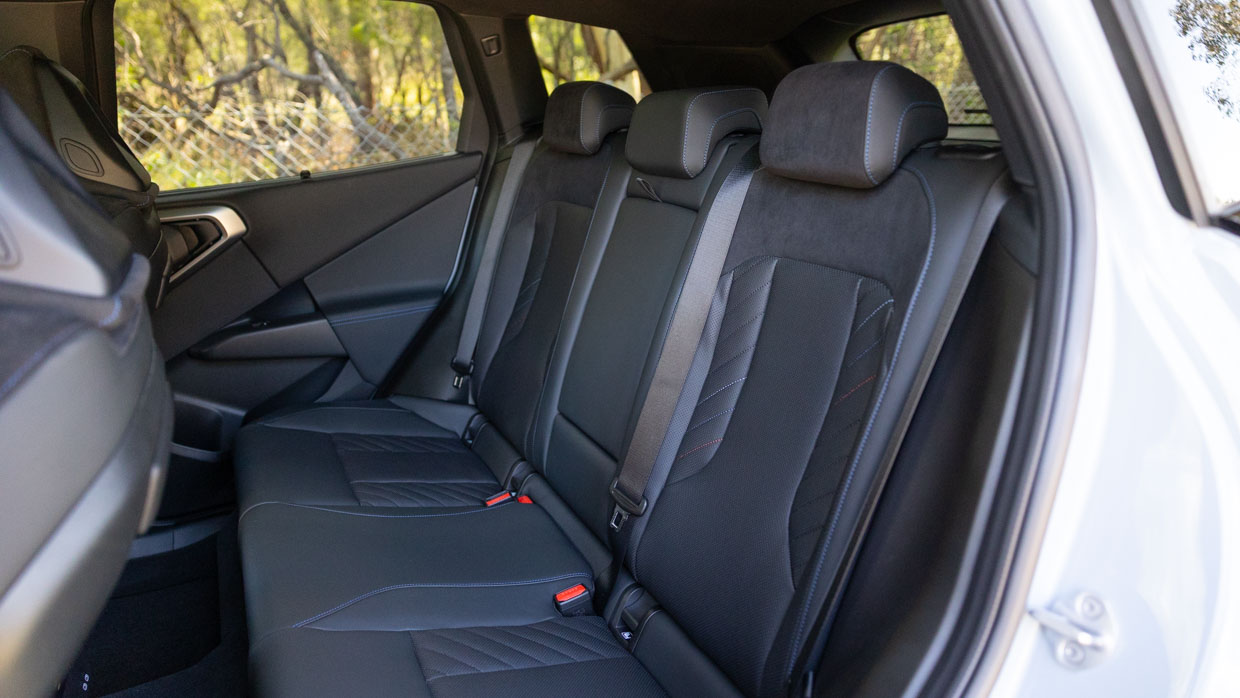
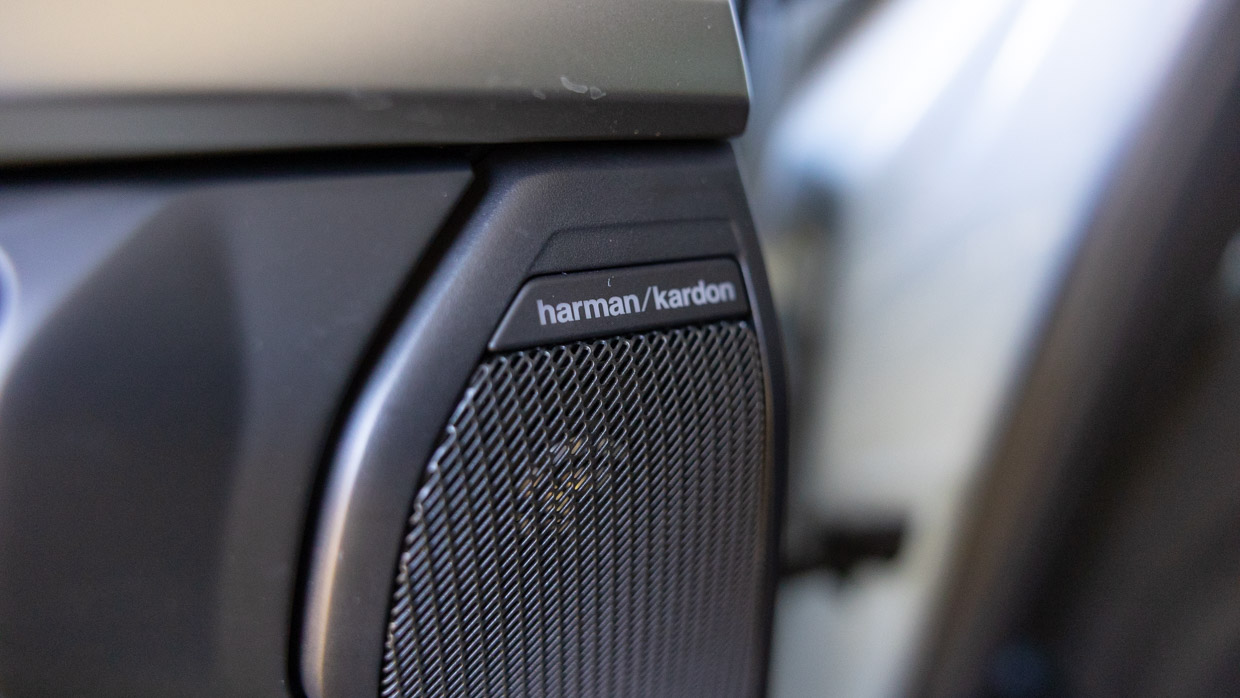
As a family conveyance, the X3 does a terrific job in providing great vision and genuine comfort for four people, though you need to add the Comfort and Enhancement packs to get a glass roof, ventilated front seats, heated outer rear seats and a decent Harman Kardon stereo.
But what Australia’s mandatory M Sport fitment precludes is the delightful cloth trim of the European X3, as well as its classy two-spoke steering wheel. Instead, we get vinyl and a needlessly thick three-spoke M wheel.
Like the impressively finessed cabin comfort and practicality, the X3’s boot is excellent.
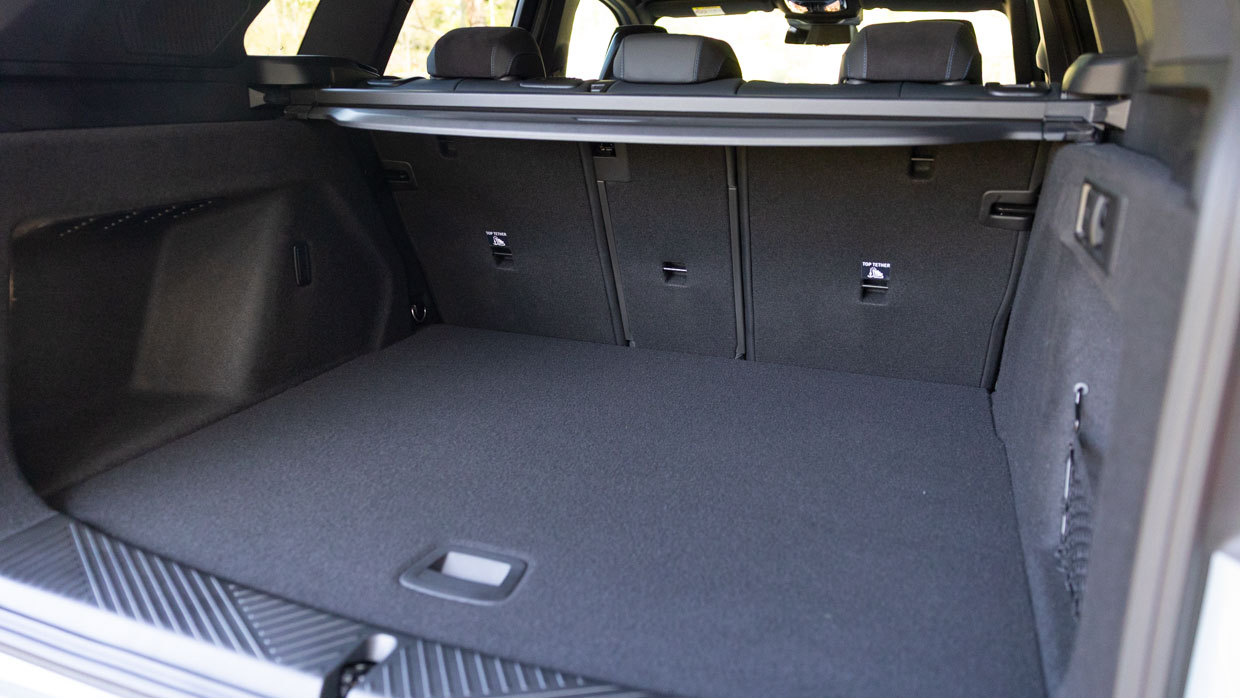
Measuring 20 litres larger at a best-in-class 570 litres below a smooth, high-quality luggage cover, the X3’s split rear backrests fold almost flat to expand its luggage capacity significantly. For a medium SUV, the new X3 goes some way towards offering a near-large level of cargo space.
Is the X3 20 a safe car?
The BMW X3 hasn’t been independently crash tested by Euro NCAP since 2017 – meaning there is no official star rating for the new-generation of X3. The previous model received five stars, and we’d expect the new G45 generation to be no different.
Standard safety equipment on the 2025 X3 20 includes the Driving Assistance Professional bundle that includes:
- Adaptive cruise control (up to 210km/h)
- Steering and lane-control assist
- Lane-change assistant
- Active/adaptive navigation
- Lane-keep assistance
- Active side collision protection
- Road priority and wrong-way warning
- Front cross-traffic alert
- Emergency stop assistant
- Emergency lane assistant
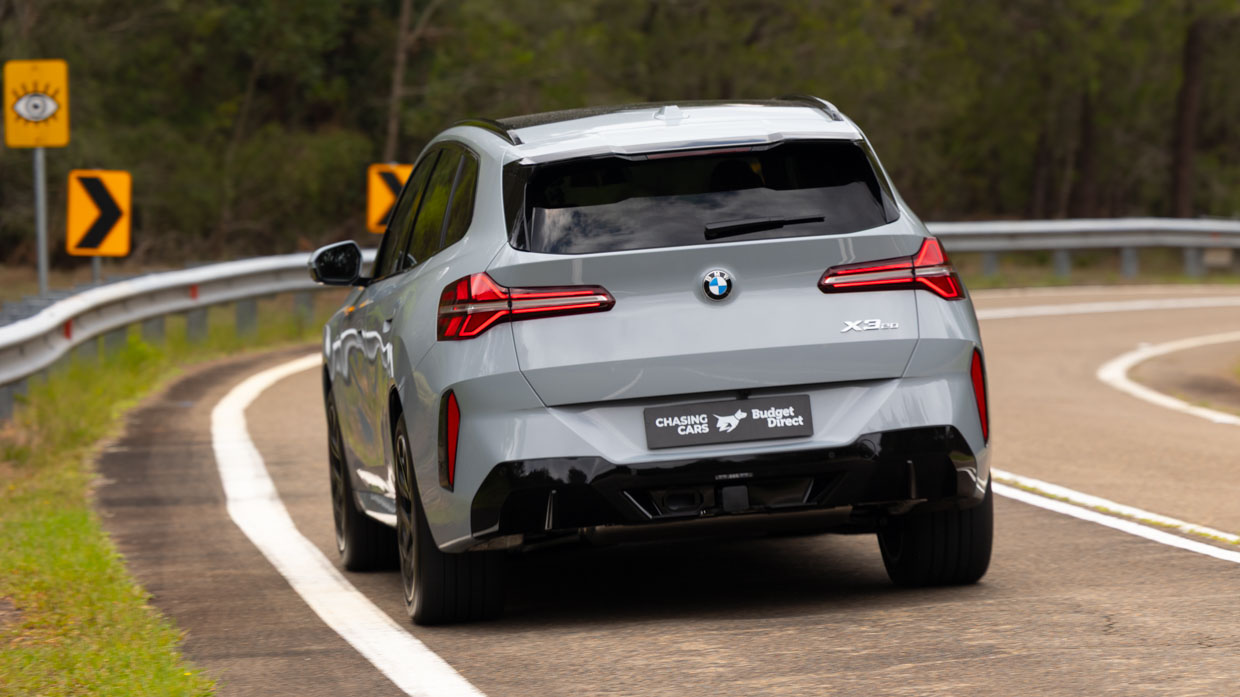
Other safety features fitted include:
- Forward collision warning
- Front AEB with pedestrian and cyclist detection
- Lane-departure warning
- Blind-spot monitoring
- Rear collision prevention
- Rear cross-traffic alert
- Rear cross-traffic AEB
- Speed-limit assistance (with auto function)
- Vehicle exit warning
In our experience, the X3’s active-safety aids proved wonderfully subtle yet highly effective, with mainly the lane-keep assistance making its presence known – providing light, subtle adjustments to steering angle without removing control from the driver.
Compared to the litany of utterly hideous electronic safety systems we’ve experienced lately – most of them on Chinese-brand EVs, as well as several Korean vehicles – BMW’s pragmatically German approach to safety assistance is joyfully considered and reassuring.
What are the X3 20’s ownership costs?
The official combined fuel consumption figure for the mild-hybrid X3 20 xDrive is 7.5L/100km, drinking 95RON premium unleaded, which calculates to 867km of range from its 65-litre tank.
In comparison, Mercedes-Benz’s more powerful GLC 300 uses 7.7L/100km combined while Audi’s similarly grunty Q5 2.0 TFSI quattro achieves 7.2L/100km combined.
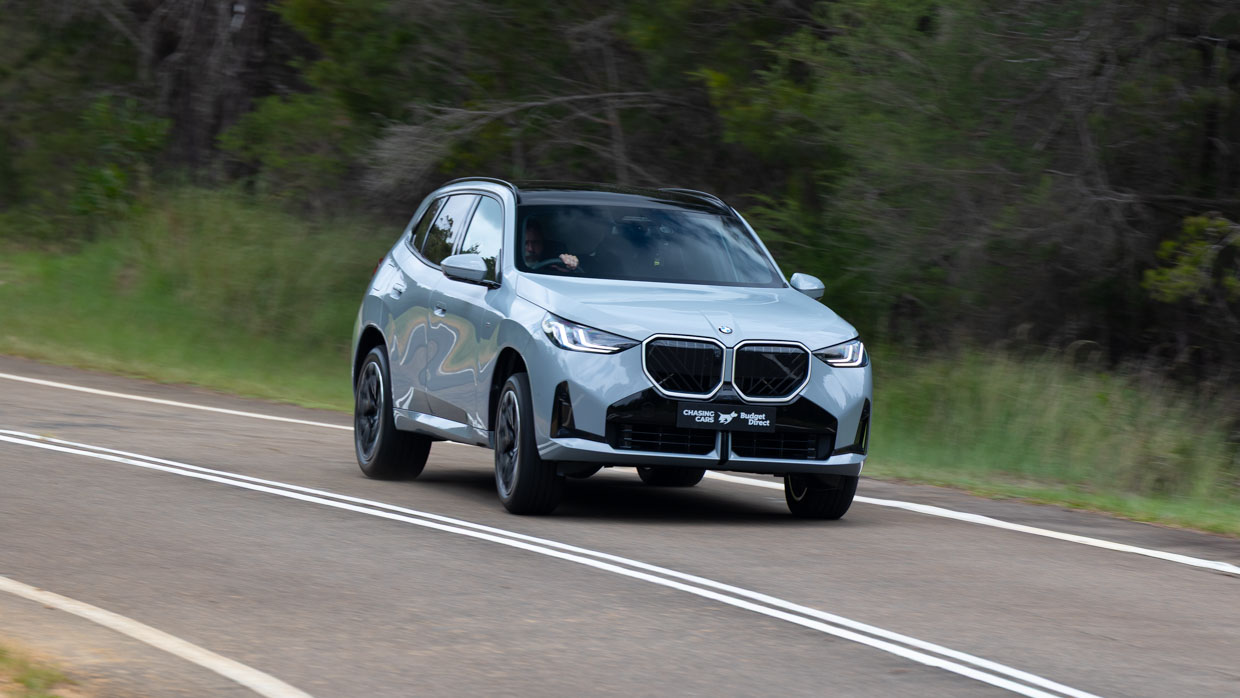
Over more than 700km of testing, we averaged an excellent 7.6L/100km in the X3 20 – including a return trip from Sydney to Bathurst averaging 6.6L/100km, which is bang on the official Extra Urban figure.
Recommended service intervals are approximately every 12 months or 20,000km, depending on your driving demands. BMW offers two Service Inclusive Basic packages – three years/40,00km or five years/80,000km, with the five-year package costing $2475 for an X3.
BMW’s new-vehicle warranty in Australia is five years/unlimited kilometres, combined with a 12-year/unlimited-kilometre Body Rust Perforation warranty. Roadside assistance for the X3 petrol line-up is three years/unlimited kilometres.
The honest verdict on the X3 20
There’s much to be said for conserving resources and making the most of what you have, which is what BMW has achieved with the new G45 X3. It isn’t completely new from the ground up, but it’s an excellent example of how to hone and refine an existing formula, giving it enough life to survive into the next decade.
The X3 we tested here – a 2.0-litre AWD automatic with M Sport accoutrements and 20-inch wheels – is surprisingly cohesive as an overall package and impressively capable in almost all areas.
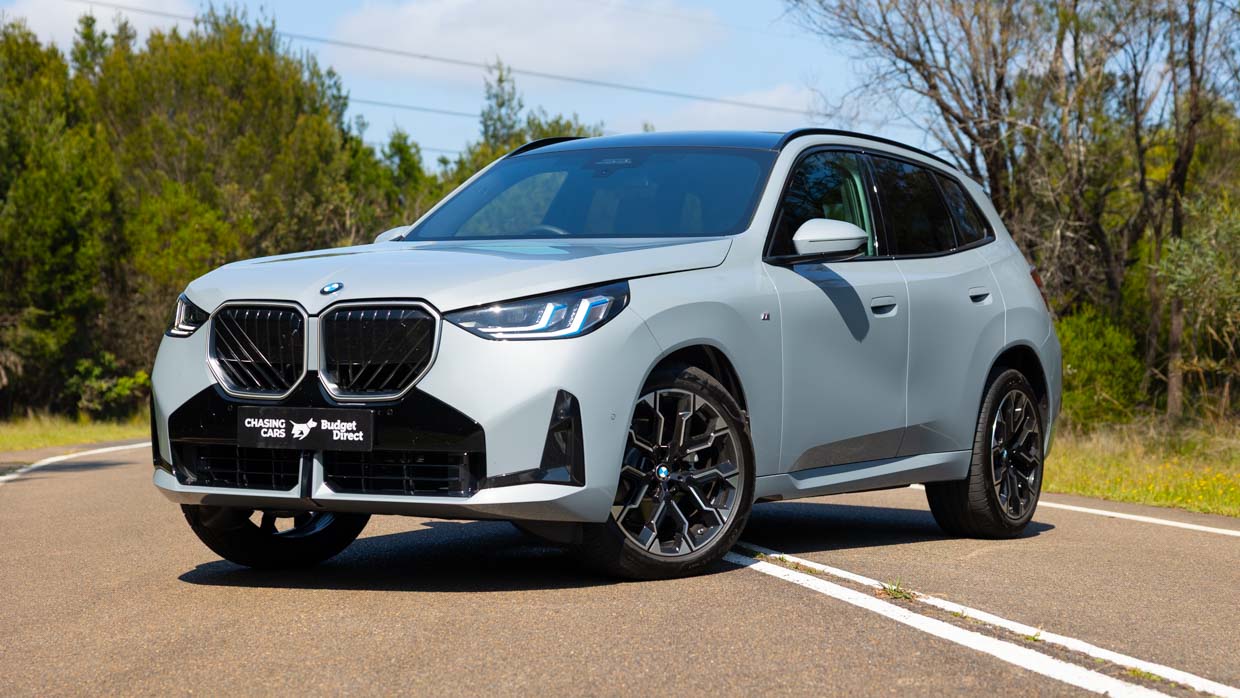
It’s a pity that BMW chose the 140kW engine tune for the base X3 rather than a 190kW version in a potential X3 30, however if you value outstanding urban driveability and don’t place too many challenging demands on your X3 20, it’s a capable and sophisticated powertrain.
Yet even when you do, it eagerly offers up everything that it has.
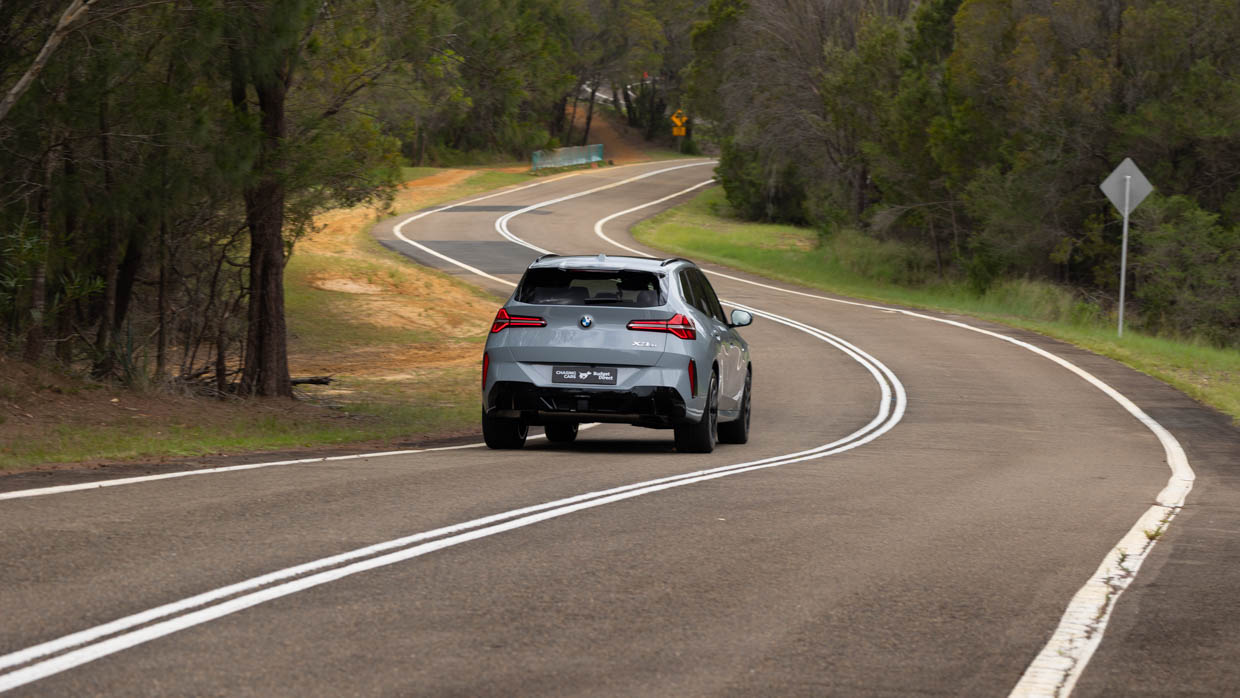
The only area where the new X3 appears to have taken a backwards step is in some of its interior plastics – in particular the door pulls, the door air-vent area and the lower dash section. They’re not in keeping with its excellence elsewhere, from its fabulous seating to its terrific packaging and otherwise classy finish.
If you want the best-handling medium SUV on the market, however – regardless of price point – the new BMW X3 finally delivers what its branding promises.



